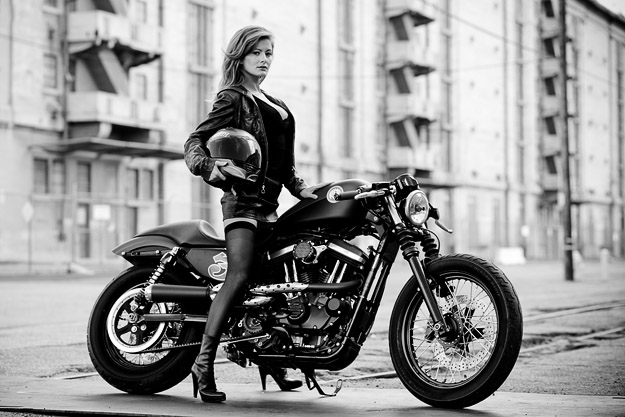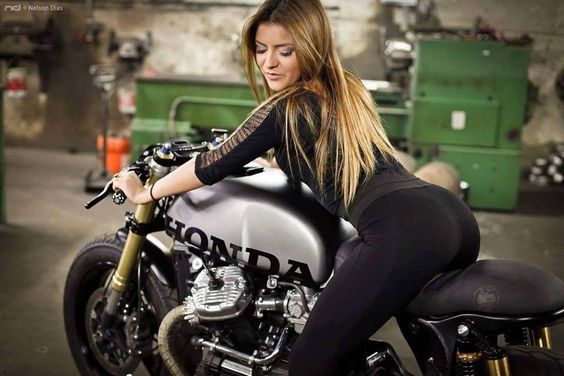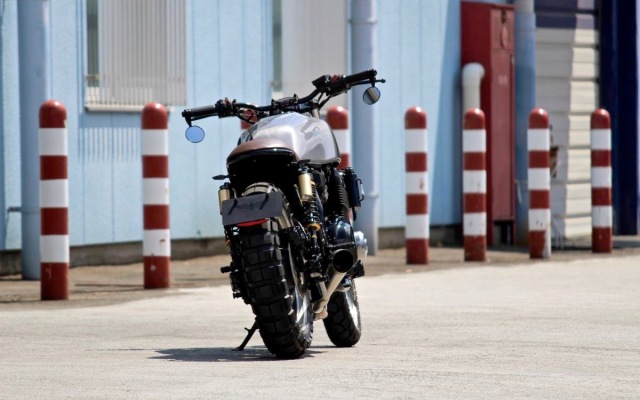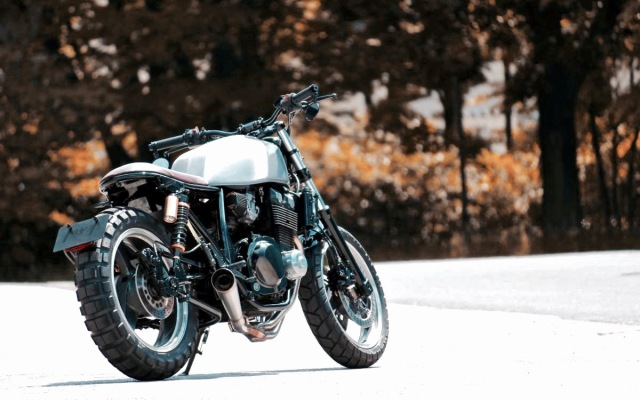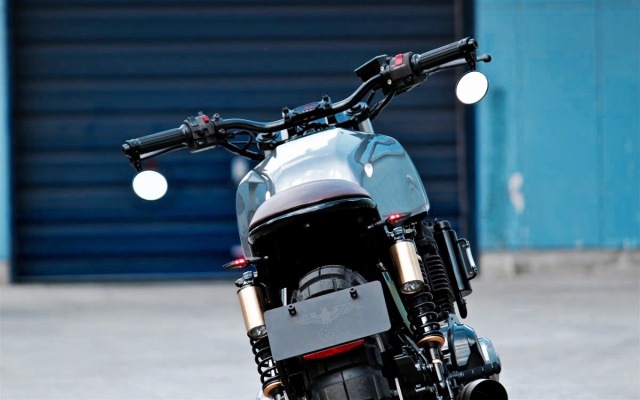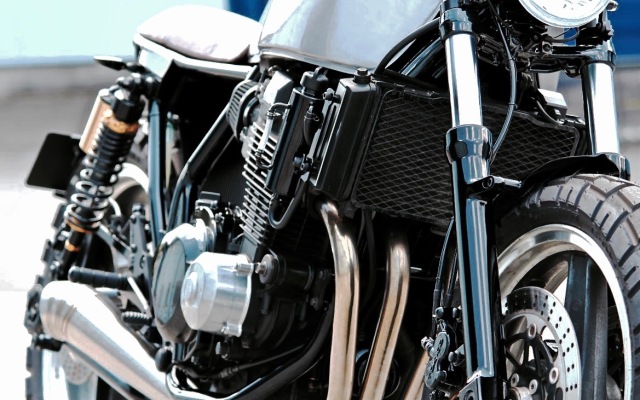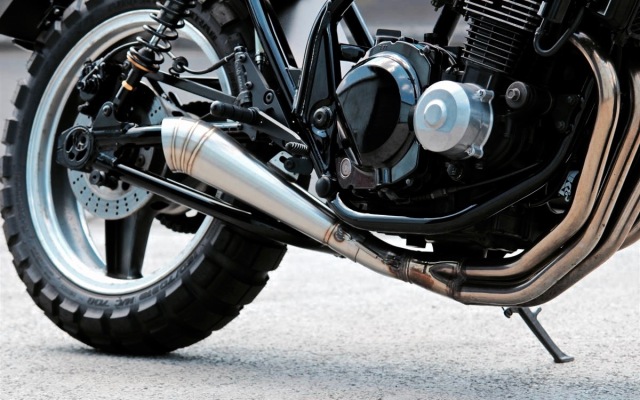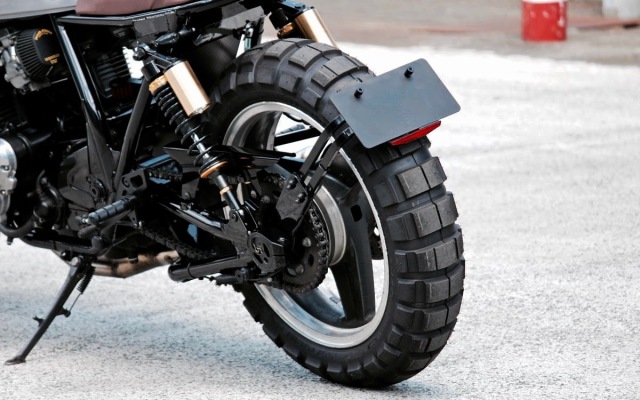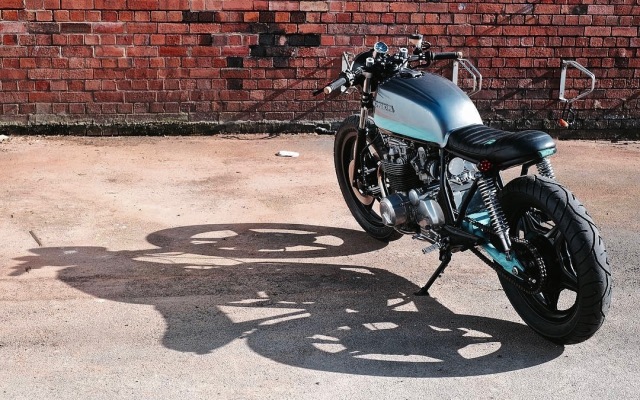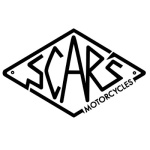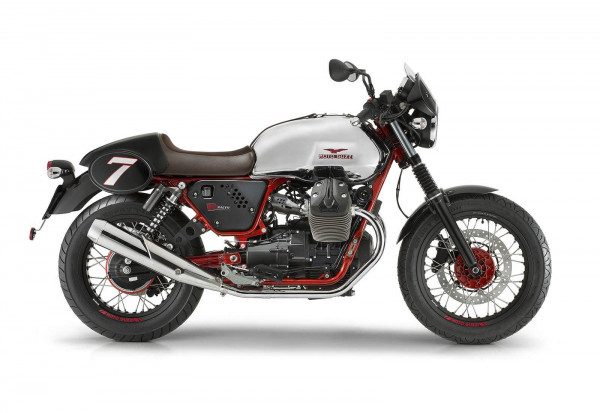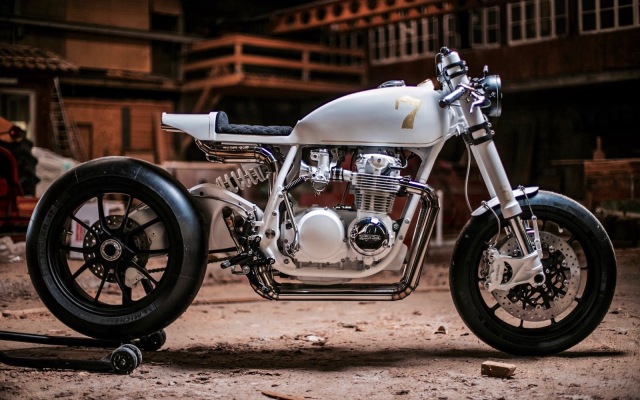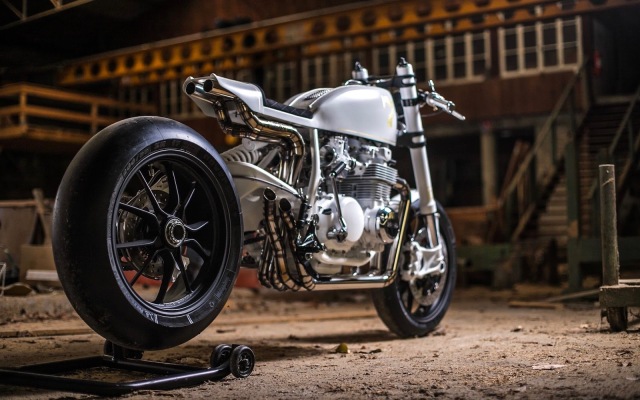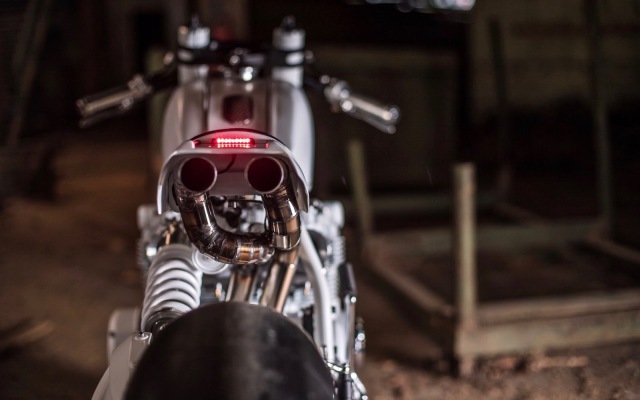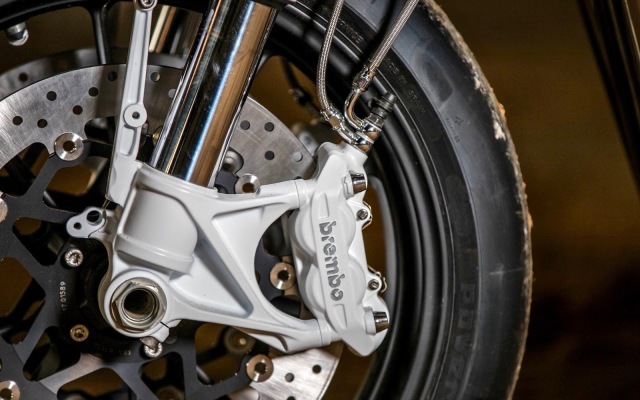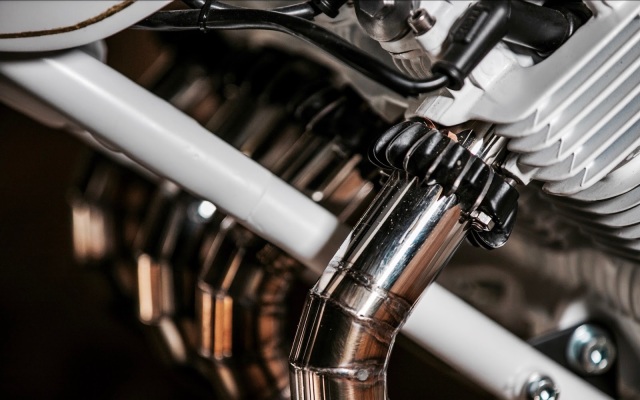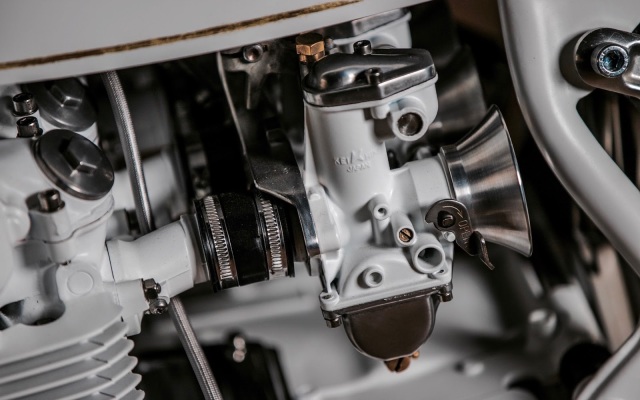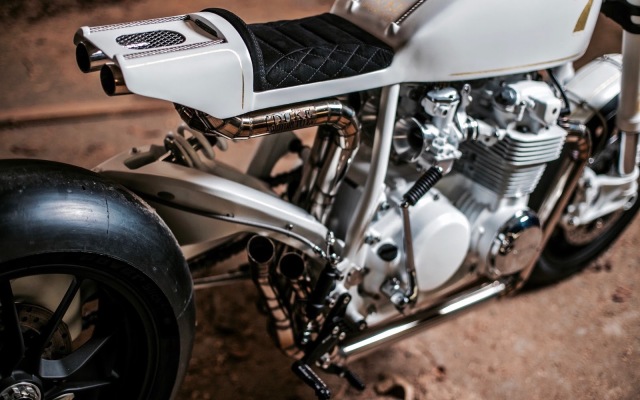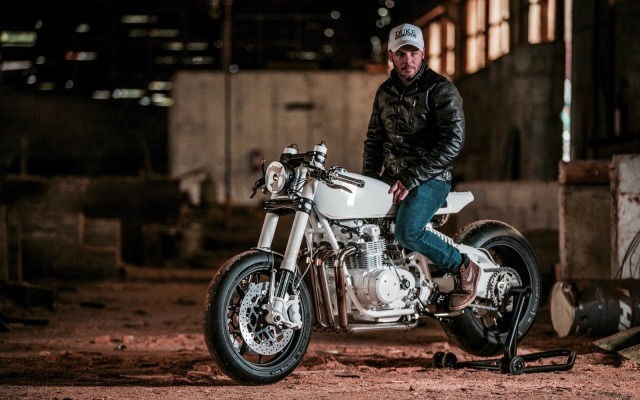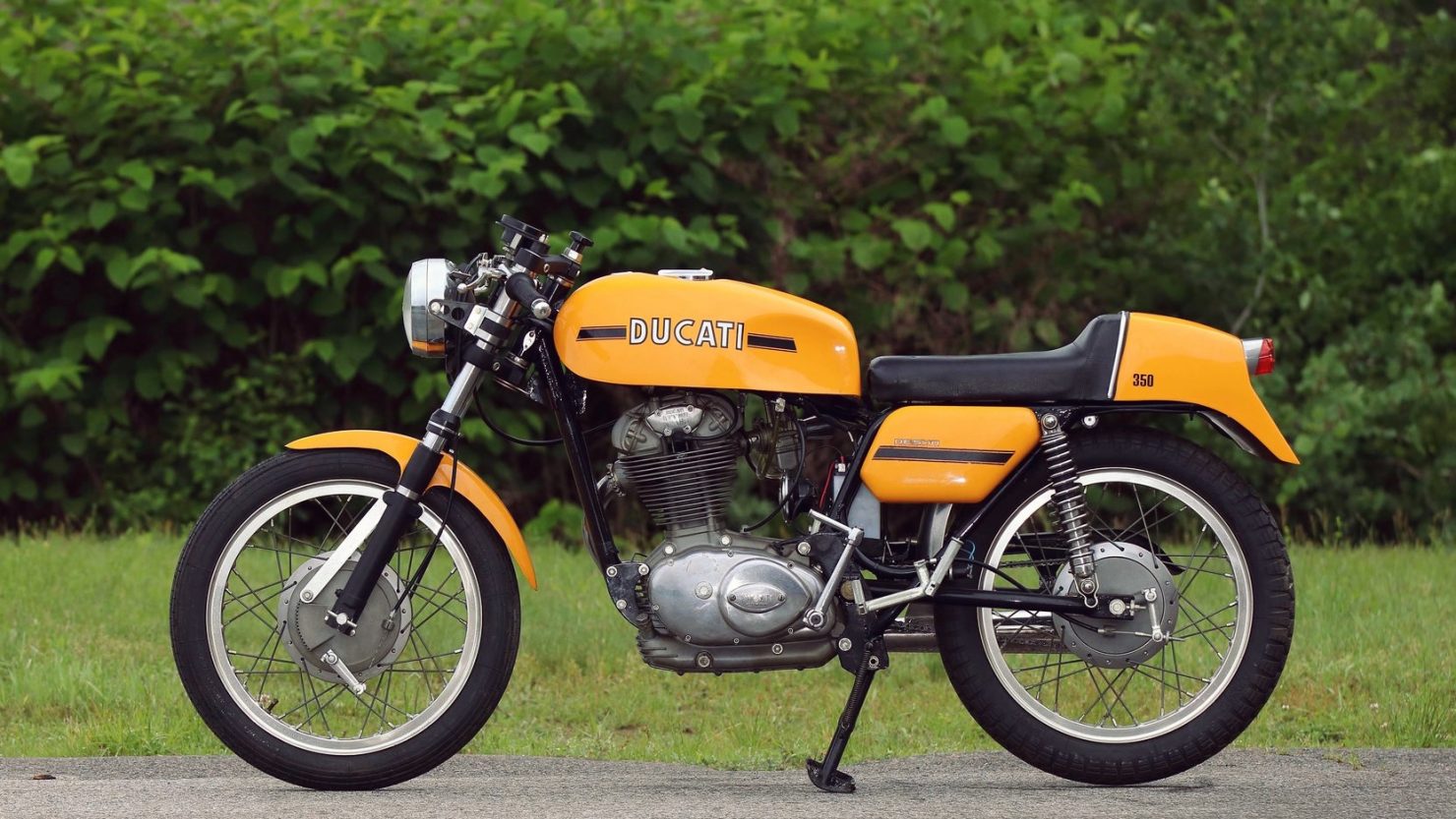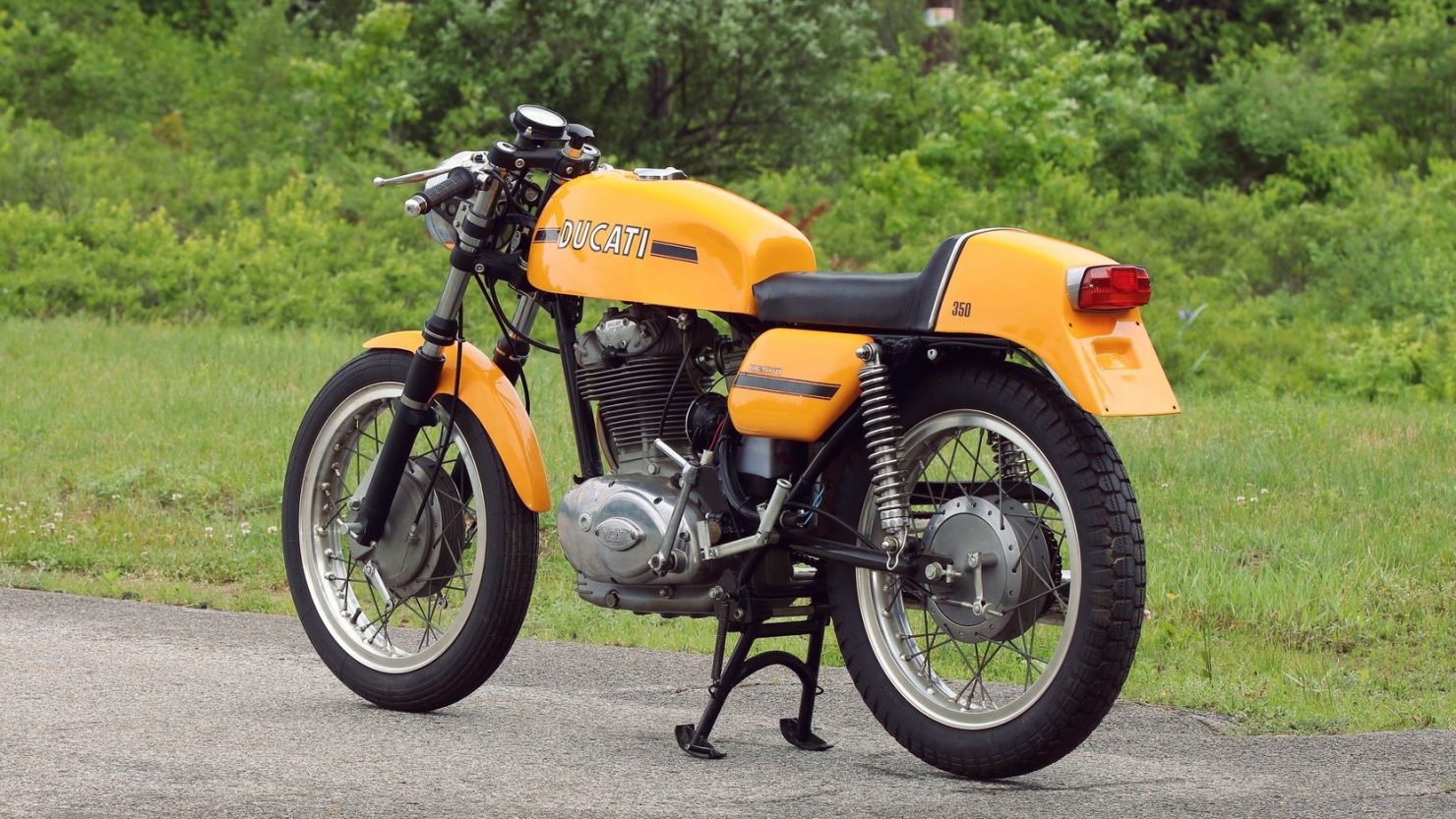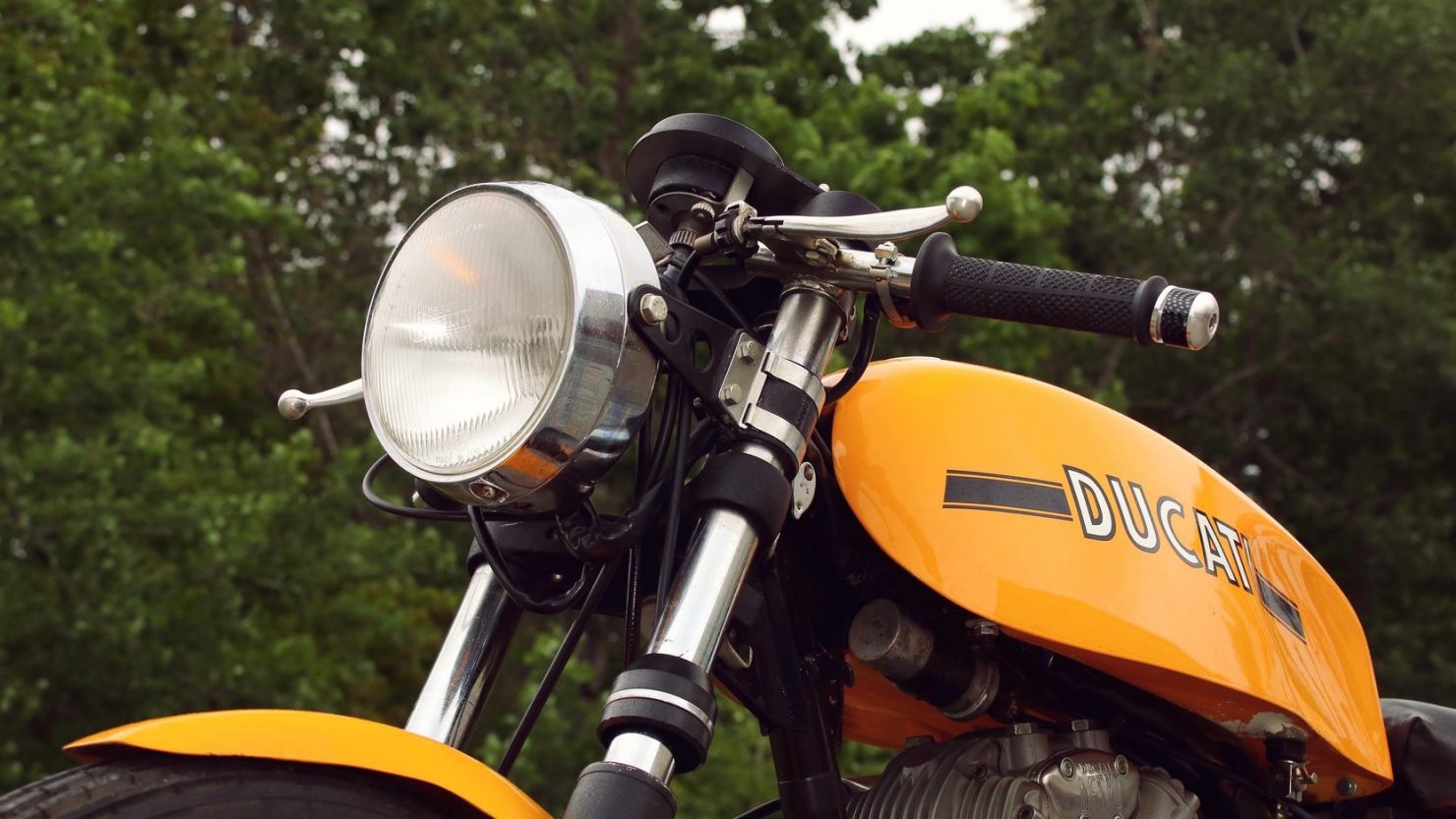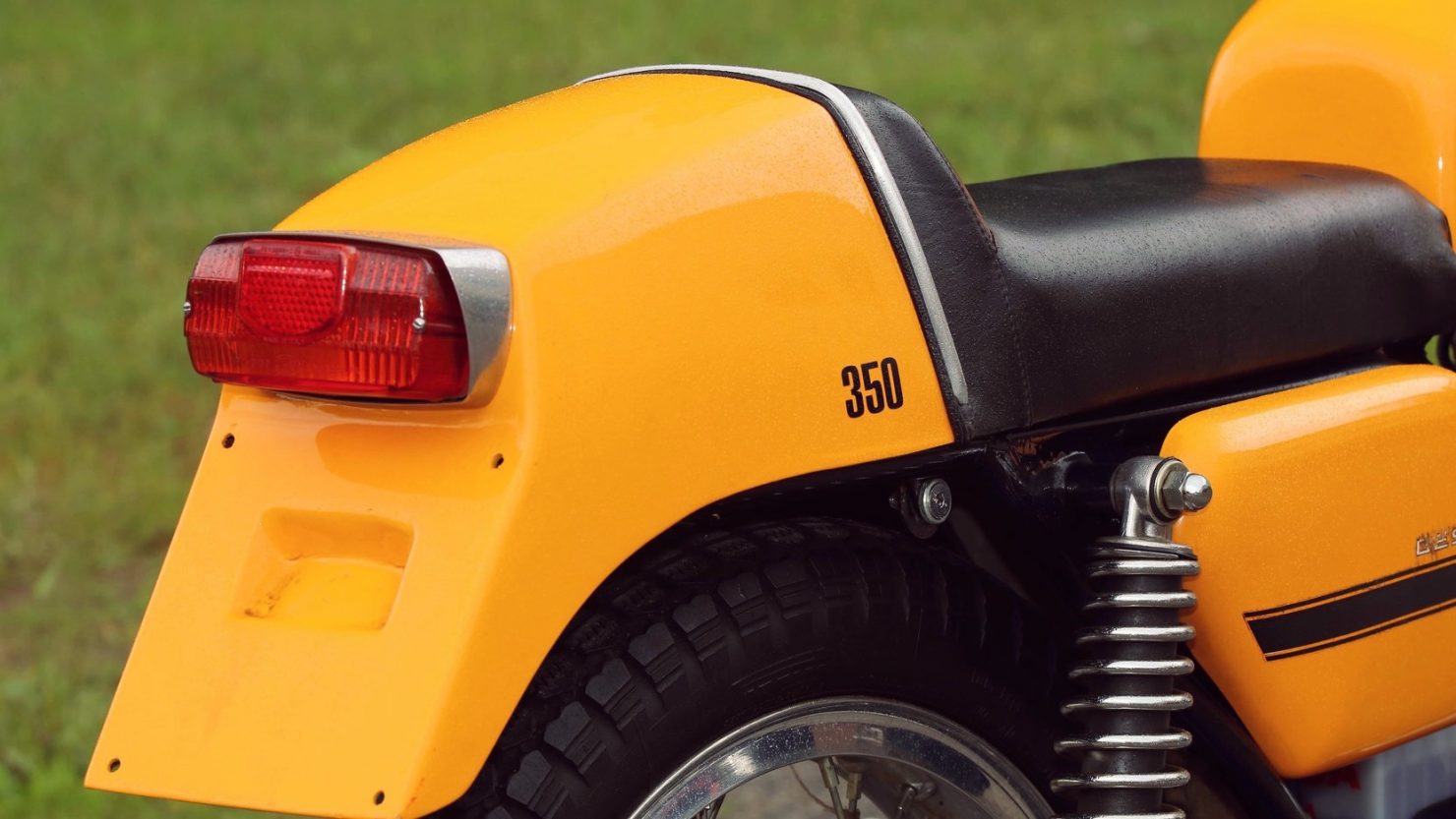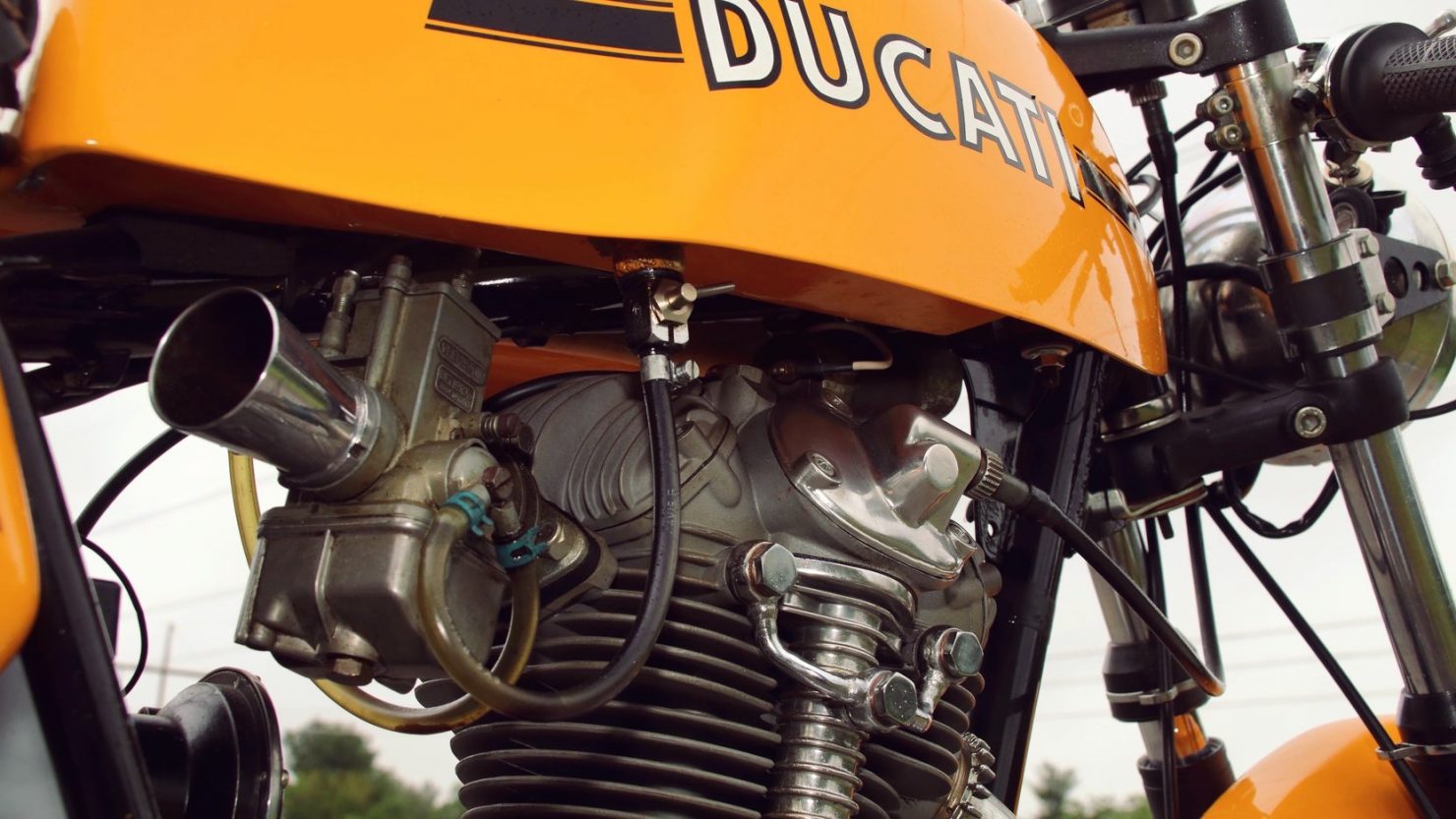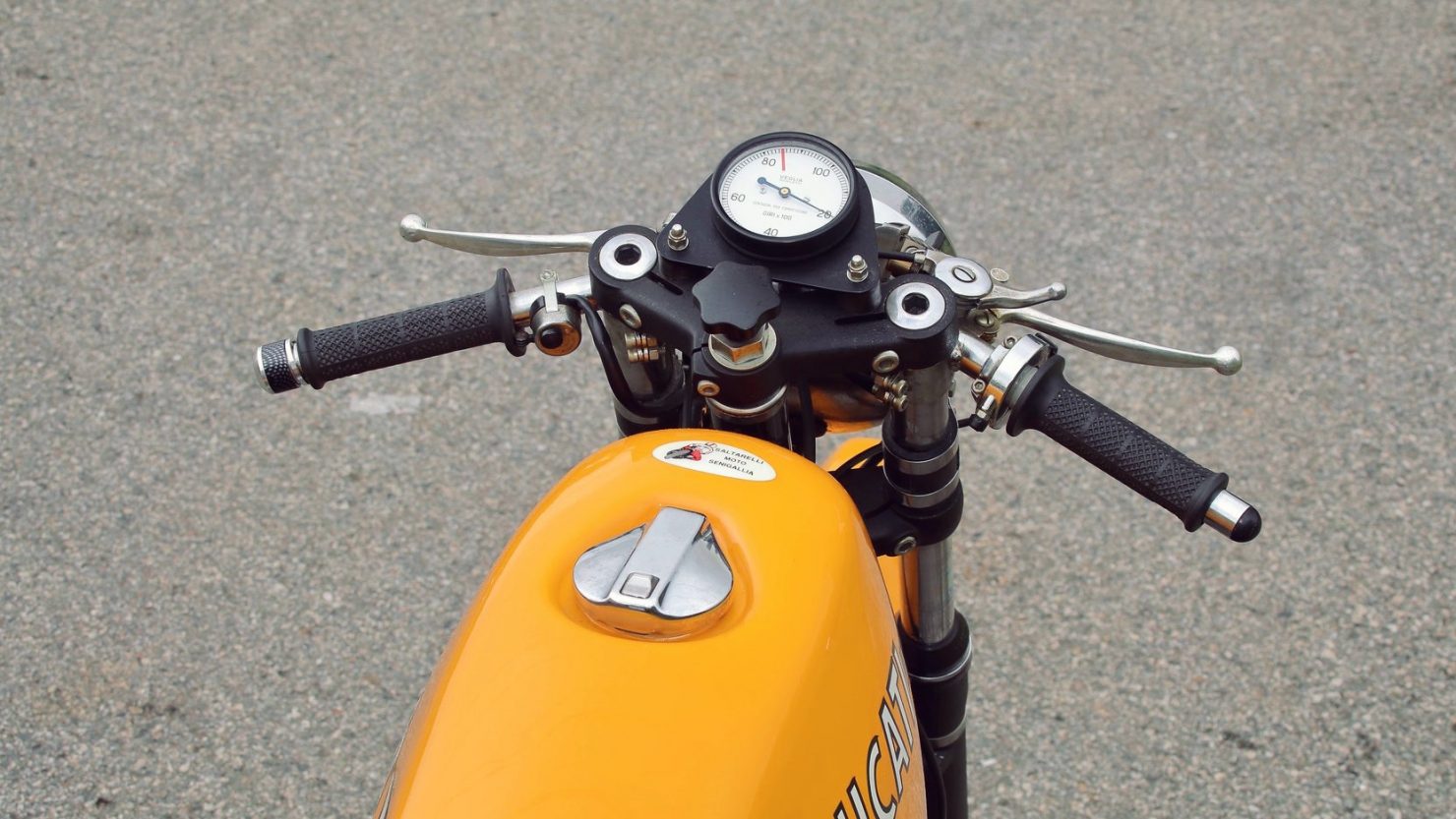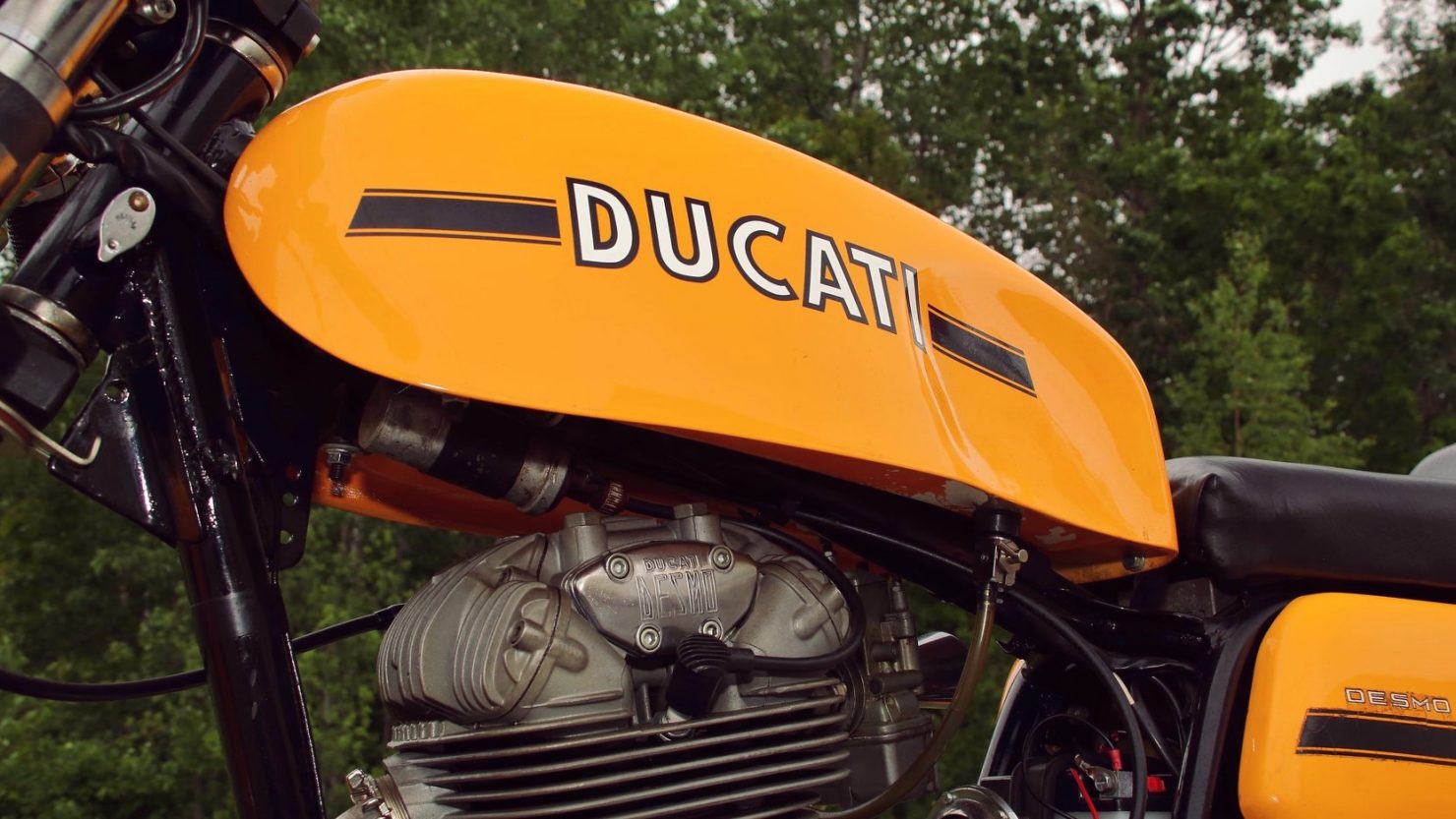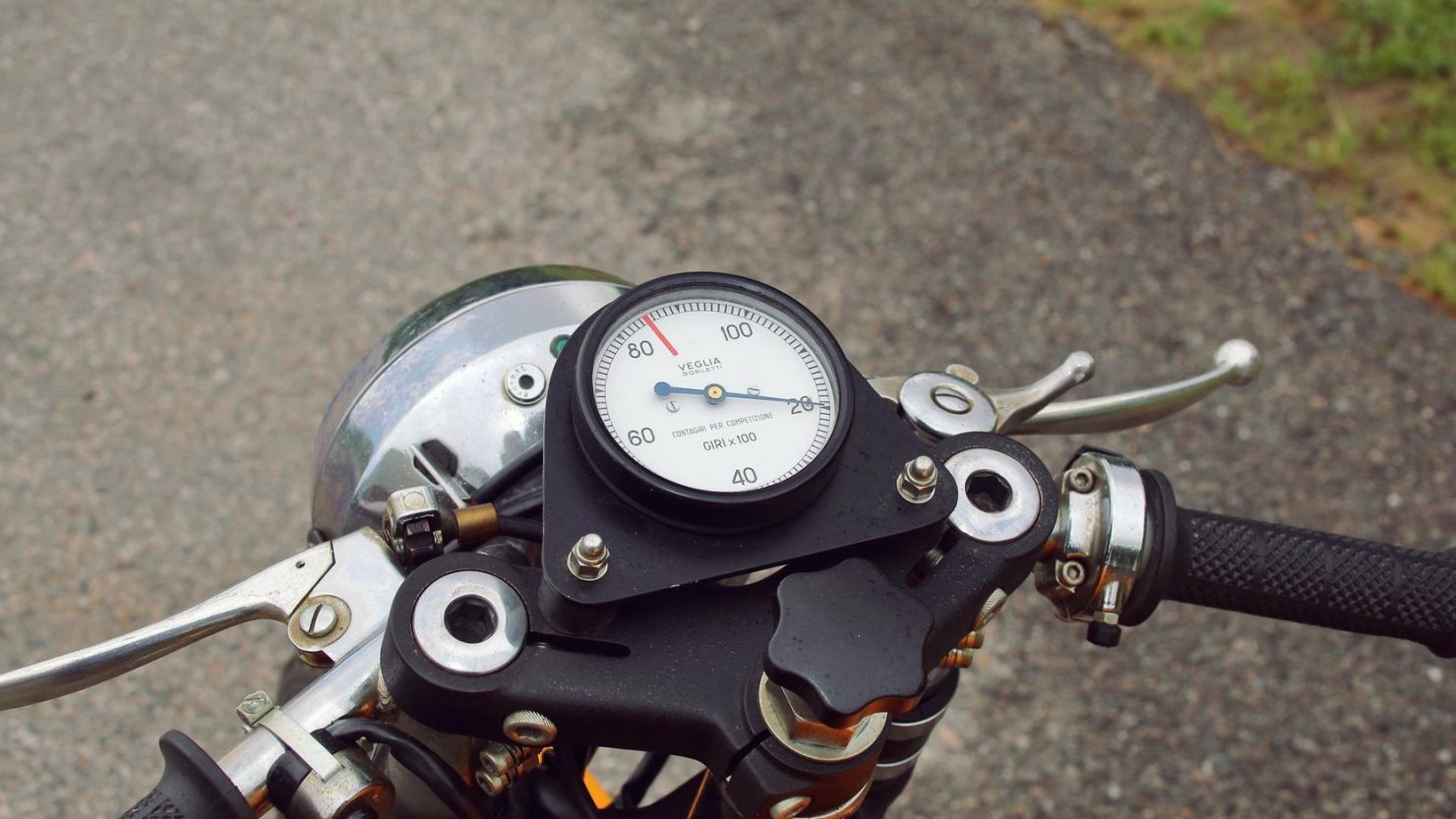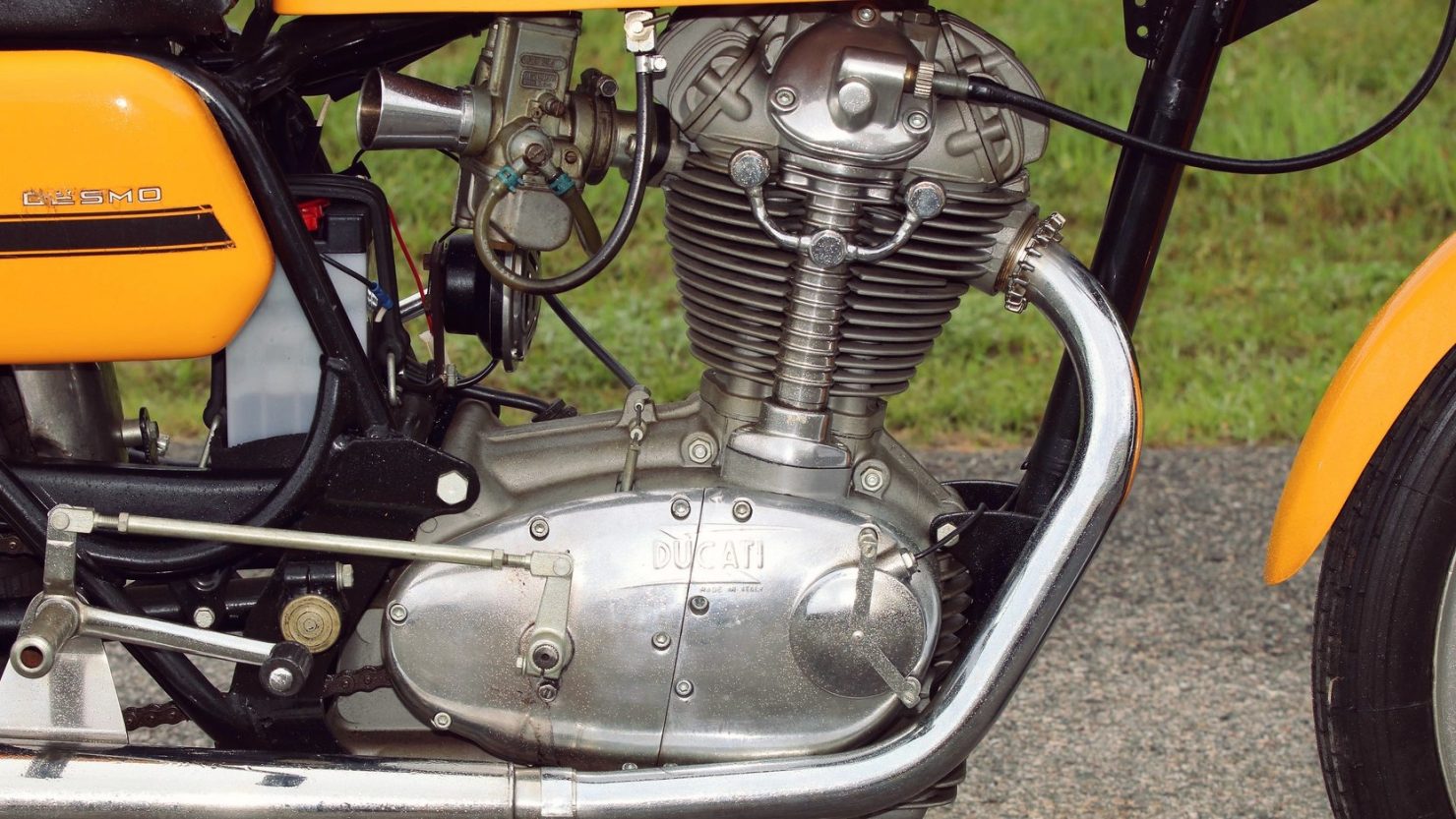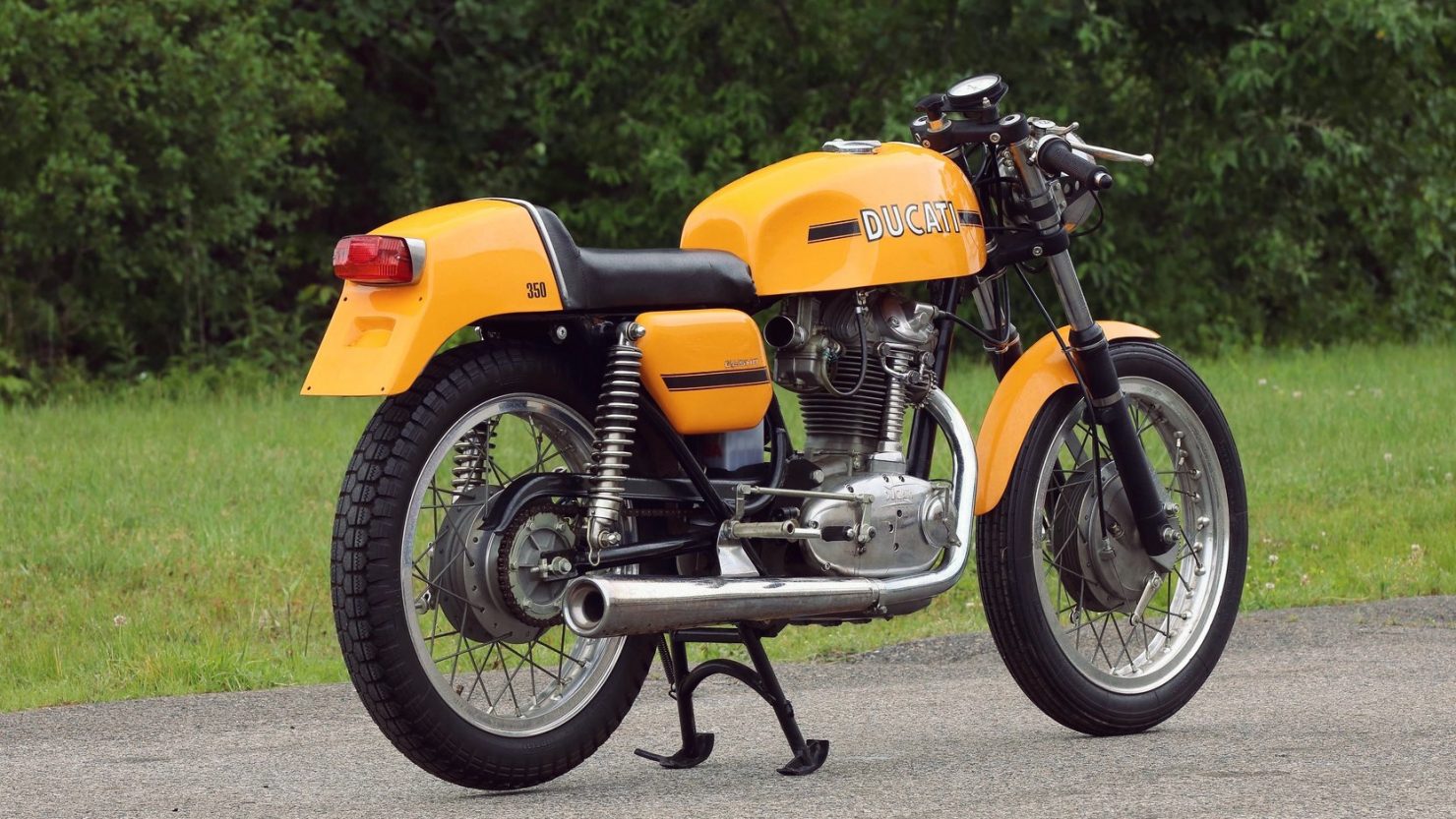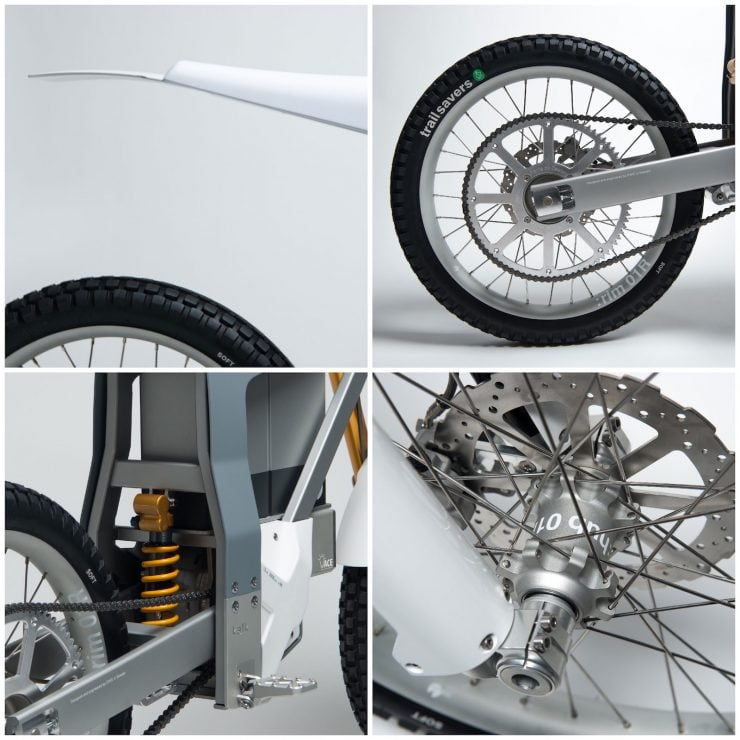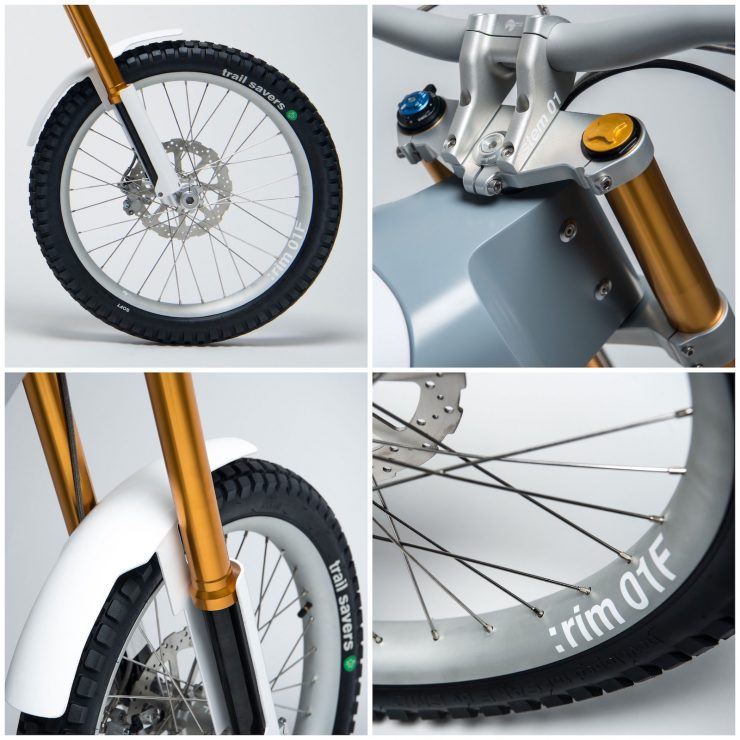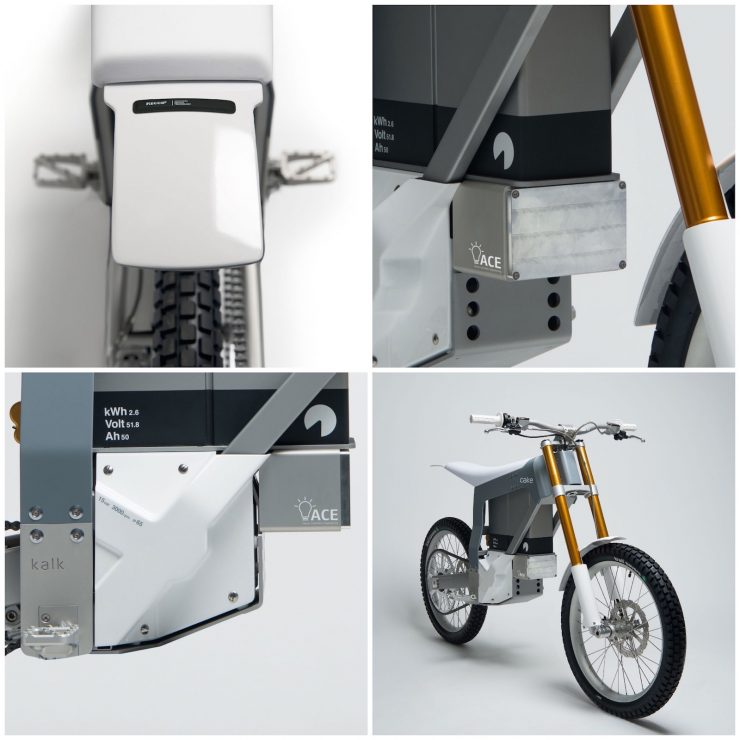G-Zac Scrambler Four
The Bristolian
12 Best Modern Cafe Racer Bikes
A modern cafe racer is the solution for those who can’t/won’t build there own cafe racer or just don’t want to have the maintenance of an old bike. Building your own bike is awesome, but also requires a lot of time, effort, skills, knowledge, space etc. Since the scene for cafe racers is constantly growing, motorcycle manufacturers saw a new niche: the modern cafe racer. These are bikes with a classic look, but with the technology of a modern motorcycle like modern brakes, suspension, fuel- and electrical systems.
While this post originally contained a list of 5 modern cafe racers, it organically grew into a full list without a specific number, plus some other cool modern classics.
Modern cafe racers
#1 Moto Guzzi V7 Racer (2012 -)
 Stock price: $10,490 (2015)
Stock price: $10,490 (2015)The absolute champion of the modern cafe racers is the Moto Guzzi V7 Racer. With no doubt one of the best looking bikes you can buy. It’s characteristic (grumpy and bumpy), high torque 744cc v-twin puts out around 48hp and is powered with a shaft drive. 48hp doesn’t sound like a lot, but when you look at the dry weight of 179kg and consider the torque of 43Nm, you know that’s it’s a lot of fun to ride. And then that sound….! Count on a lot of neck-twists when riding this beauty!
The VII model (2015 and up) has more power and some new features like ABS, traction control (!), 6 gears and a better weight distribution.
Also the other V7’s (V7 Classic, V7 Stone, V7 Special) are cool retro bikes. The custom parts list is extensive and expensive, but why change this beautiful design?
PS. I actually have a 2014 V7 RAcer and one thing is for sure: it’s an awesome ride!
#2 Triumph Thruxton (2004 – )

Stock price: $9,799 (2015)
Another “heavyweight” champion between the modern cafe racers is the Triumph Thruxton. We’ve set this one at 2nd place because the fact that the bike is actual very heavy for a cafe racer: the dry weight is 214kg. Despite the fact that the 865cc parallel-twin has more power (69hp and 51Nm) than the Guzzi V7 Racer, it has also more “fat” to move.
Beautiful design, powerful engine and lots of ways to personalize it. Not only a great choice for those who just want to buy-and-ride, it’s also a bike custom builders like to work with.
#3 Triumph Thruxton R (2016 -)

Stock price: approx. $14,500
Maybe one of the most exciting modern café racers out there: the 2016 Triumph Thruxton R. Not only a beautiful designed bike, but also a bike with some serious performance:
The brand new liquid cooled 1200cc (“high torque”) engine puts out a blasting 112Nm and just under 100hp. Combined with the fully adjustable Showa front USD fork, fully adjustable Öhlins rear shocks, top notch radial brakes with Brembo monoblocs and a weight just over 200kg makes this bike maybe a bit too modern…
#4 Royal Enfiel Continental GT (2014 -)


Stock price: approx. $8,300 (2015)
Almost 50 years after the introduction of the Royal Enfield, they’ve now got an answer to the demand for modern cafe racers: the Continental GT. Its single cylinder engine with 535cc puts out 29hp and 44Nm to move the 184kg of dry weight. Not the fastest modern cafe racer, but it’s got the looks, the sound, the ride is good and the single cylinder torque makes it a desirable bike. And at a price of $8,300, not too expensive.
UPDATE: New Royal Enfield 650 Twins (2017)
In 2017, Royal Enfield presented their all-new 650cc twin cylinder engines with a 270-degree crankshaft; the rebirth of the parallel twin.
Royal Enfield Continental GT

Royal Enfield Interceptor

#5 Ducati Sport1000 (2006 – 2009)
 Stock price: $12,995 (2009, 1000s)
Stock price: $12,995 (2009, 1000s)The Ducati Sport1000 is a direct inspiration of the 1973 Ducati 750 Sport with a typical one seated cafe racer look. For t a stock price of $12,995 you got a lightweight bike with adjustable suspension, USD front fork, Brembo brakes and a powerful 2 cylinder engine. The remarkable 992cc L-twin puts out an awesome 92hp and 90Nm. Considering the weight of 179kg this thing goes like a rocket! Too bad that they’ve stopped the production of this awesome modern classic in 2009 and that there aren’t a lot of used models to find.
#6 BMW R nineT (2014 – )
 Stock price: $14,995 (2015)
Stock price: $14,995 (2015)In 2014BMW came up with an answer to the modern cafe racer: the awesome BMW R nineT. The price of almost 15k is high, but you get a lot for that: adjustable USD fork & rear shock, Brembo brakes (with ABS), single seat and classic cafe racer rear end, beautiful wired wheels and a powerful BMW boxer engine which transfers al the power to the rear wheel with a shaft drive.
came up with an answer to the modern cafe racer: the awesome BMW R nineT. The price of almost 15k is high, but you get a lot for that: adjustable USD fork & rear shock, Brembo brakes (with ABS), single seat and classic cafe racer rear end, beautiful wired wheels and a powerful BMW boxer engine which transfers al the power to the rear wheel with a shaft drive.
 came up with an answer to the modern cafe racer: the awesome BMW R nineT. The price of almost 15k is high, but you get a lot for that: adjustable USD fork & rear shock, Brembo brakes (with ABS), single seat and classic cafe racer rear end, beautiful wired wheels and a powerful BMW boxer engine which transfers al the power to the rear wheel with a shaft drive.
came up with an answer to the modern cafe racer: the awesome BMW R nineT. The price of almost 15k is high, but you get a lot for that: adjustable USD fork & rear shock, Brembo brakes (with ABS), single seat and classic cafe racer rear end, beautiful wired wheels and a powerful BMW boxer engine which transfers al the power to the rear wheel with a shaft drive.The air-cooled 1170cc boxer engine is good for 110hp and a crazy torque of 119Nm. With a dry weight of 222kg it’s sure is not the lightest, it’s handling and power makes it feel lighter than you expect. The R nineT is also a good bike for daily use.
UPDATE: in October 2016,BMW revealed the 2k cheaper R nineT Racer:
revealed the 2k cheaper R nineT Racer:
 revealed the 2k cheaper R nineT Racer:
revealed the 2k cheaper R nineT Racer:
#7 Norton Commando 961 (2006 -)
 Stock price: $20,300 (2013)
Stock price: $20,300 (2013)The number 7 on this list is a bonus, merely because of its exclusivity and price. The Norton Commando 961 is a cafe racer with pure cafe racer blood, taking you back to the original Commandos. It’s air-cooled 961cc 2 cylinder engine has 80hp and 90Nm to move 202kg of dry weight. The bike comes with state of the art parts like Brembo brakes and Öhlins suspension.
We think that the price of over 20k is a bit high. But it’s a desirable bike, in fact: it’s hard to find a used on under the stock price…
#7a New Norton Dominator

Stock price: approx. $28,500 (2018)
Maybe even more desirable than it’s brother is Norton’s brand new Norton Dominator. Some say that the new Dominator is a direct answer to the Triumph Thruxton R. If you take a straight comparison, the Thruxton takes over the Dominator with its performance. That’s not a problem at all, because thatNORTON IS way more exclusive; a handmade polished gas tank, carbon fiber seat, mudguards and covers, a big fat black Öhlins USD fork with Brembo Monoblox, a Öhlins TTX36 in the rear and all those other details… Beautiful, but unfortunately for most of us, unreachable.
way more exclusive; a handmade polished gas tank, carbon fiber seat, mudguards and covers, a big fat black Öhlins USD fork with Brembo Monoblox, a Öhlins TTX36 in the rear and all those other details… Beautiful, but unfortunately for most of us, unreachable.
 way more exclusive; a handmade polished gas tank, carbon fiber seat, mudguards and covers, a big fat black Öhlins USD fork with Brembo Monoblox, a Öhlins TTX36 in the rear and all those other details… Beautiful, but unfortunately for most of us, unreachable.
way more exclusive; a handmade polished gas tank, carbon fiber seat, mudguards and covers, a big fat black Öhlins USD fork with Brembo Monoblox, a Öhlins TTX36 in the rear and all those other details… Beautiful, but unfortunately for most of us, unreachable.Other modern classics
These are no modern cafe racers, but cool modern bikes with a classic twist:
#8 Ducati Scrambler (2015 – )

Stock price: $8,495 (Icon)
The Ducati Scrambler (or Scrambler Ducati like the Italians call their bike…) is a real modern classic inspired by the lightweight Ducati Scramblers from the 60’s and 70’s. Although they don’t want to call this retro bike a retro bike… The Scrambler is put down to the bare essentials of motoring but has high-quality parts like Brembo brakes with ABS, LED lights and Kayaba suspension.
The bike comes in 4 different trims: the Icon, the Classic, the Urban Enduro and the Full Throttle, each with a different styling and options.
Its 803cc air-cooled L-twin puts out 75hp with 68NM torque, and is taken from the Ducati Monster 796. The bike weights only 170kg which gives this bike a huge fun factor. No to mention the price under 10 grand.
UPDATE: Ducati Scrambler Cafe Racer

Price: $11,395
In 2017, Ducati introduced a specific Cafe Racer trim based on their Scrambler to fill in an important gap in their sales brochure. In addition to the standard Scrambler (Full Throttle), the bike has some dedicated cafe racer features like: clip on handlebars, short seat and removable cowl, black adonized mufflers, bar end mirrors, 17″gold cast wheels with Pirelli Diablo Rosso II tires, a radial brake pump and stiffer suspension. And last but not least: a beautiful classic black/gold color scheme based on the old days of the 1980 Ducati 900ss. Best of all is, of course, the 2 cylinder engine we already know.
#9 Triumph Scrambler (2006 – )
 Stock price: $9,399 (2015)
Stock price: $9,399 (2015)Triumph smelled the success of the Thruxton, which is on the market from 2004. To attract a different audience, they’ve launched the Scrambler in 2006. In fact the Scrambler is based on a Bonneville with (limited) off-road capabilities and a heavy-duty look (just like a scrambler is meant to be). Just like the Thruxton, Triumph has a wide variety of custom parts and accessories to personalize it.
The 865cc parallel twin has 54hp and 69Nm. Not a fast bike with the 214kg dry weight, but sure good for a lot of fun.
#10 Kawasaki W800 (2011 – )
 Stock price: $10,499 (2015)
Stock price: $10,499 (2015)The Kawasaki W800 is becoming a modern classic icon too. A real modern classic a it’s best. Lot’s of chrome, spoked wheels, long buddy seat, rubber pads on the gas tank etc.
The W800 is powered by a 773cc parallel twin with 48hp and 60Nm. Don’t expect a fast runner: the bike has a dry weight of 216kg, but with lots of torque in low RPM’s, it’s a real yesterdays cruiser.
#11: Yamaha XSR700 (2016 -)
 Stock price: $7,999
Stock price: $7,999A modern classic based on the Yamaha MT-07. Fitted with a smooth and torqy parallel twin with Yamaha’s “crossplane” technology. The bike is relatively light and puts out 74hp and 68Nm.
This bike is built to customize and Yamaha offers a wide range of custom parts and upgrades. Also check out this really cool custom Yamaha XSR700 Scrambler.
#12: Yamaha XSR900 (2016 -)

Stock price: starting from $10,500.
Another modern classic from the Japanese front: the Yamaha XSR900. Same looks and identity as the XSR700, but with more high-end parts en features and the powerful 3 cylinder engine from the MT-09 (FZ-09).
The XSR900 has adjustable suspension, a USD fork, radial (sport bike spec) brakes, ABS, adjustable Traction Control and Ride-by-Wire. The smooth and powerful 847cc engine delivers around 110hp and 87Nm of torque (final specs not yet released).
#13: Kawasaki Z900RS (2018 -)

Stock price: n.a.
Inspired by the legendary Kawasaki Z1, Kawasaki revealed a new retro bike in there line-up for 2018. Unfortunately, we don’t have a full list of specs yet, but the technique comes for the Z900, which has a 948cc four-cylinder on board. Kawasaki says that the engine is tuned down from 125 to 111hp to deliver a smoother power band below 7,000 rpm. Other highlighted specs are: fully adjustable 41mm front fork, adjustable rear shock, wave discs, traction control, ride-by-wire, For that real vintage feeling, the Z900RS has a beautiful set of laced wheels.
And? Which one is your favorite?
Do you have a favorite modern cafe racer or did we missed one? Let us know and reply!
PS. The CB1100 is missing on purpose. The stock model is missing its cafe racer soul…
The White Duke
1973 CB500 Four – white bride – cafe racer by Duke
Seen live in Verona @MBE among many other beauties but definitely not enough highlighted: Ohlins monoshock conversion, Ohlins inverted forks, Brembo brakes and braided lines, Marchesini 17″ rims wearing Michelin Power slicks and an awesome amount of custom details.
We want to see more Girls on Motorcycles
I have been into Motorcycles my whole life, I have ridden with many and all over the world, but I am now seeing more and more Girls on bikes and I love it, my girl rides, I have some girls in our 59 Club and love it when I see a girl riding with us and having so much fun.
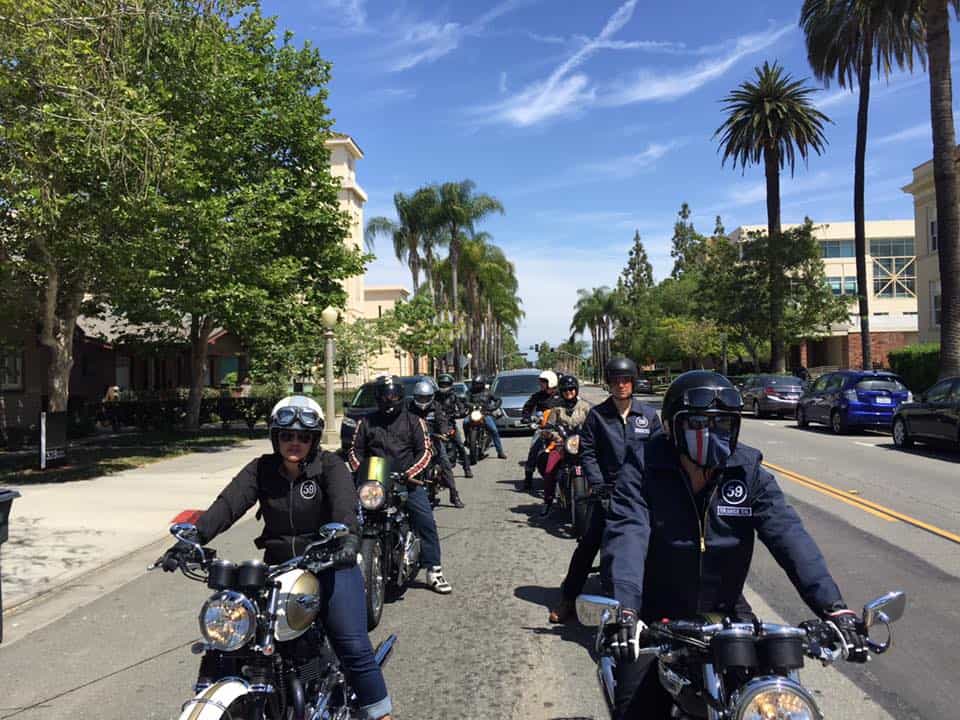
This is not a sexist Culture any more, I have many girlfriend riders back home in London and admire their tenacity and style and we sure need more of it, so come on girls come and join us at meetup.com and go for a ride. That’s my Girl above on the left, she is my Queen and am so stoked that she rides, Jennifer has fun and I sure hope that more ladies come and join us.

So have a look at these photos and I hope it inspires you to sling your leg over your steed and come and hang with us.
People have sent me photos or I have simply googled them but the images have no Credits for the photographer or Model, Please let me know if these are you or you know who it is, so they can get the recognition they deserve for their hard work.
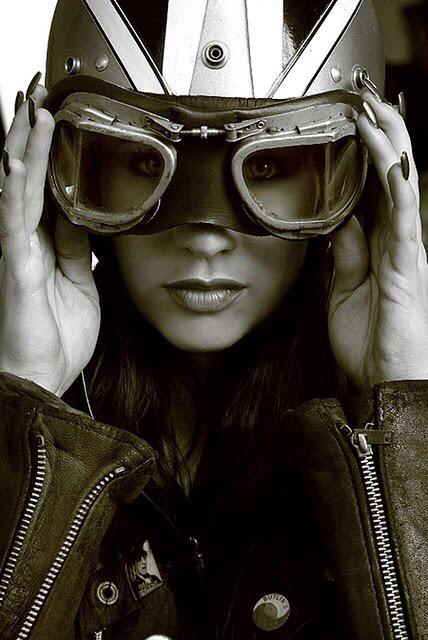
Take these photos as inspiration, some of you may already be riding and want to meet up with other Girl riders.

There is Nothing Better than seeing Girls on Motorcycles, it makes my day every time I see them.
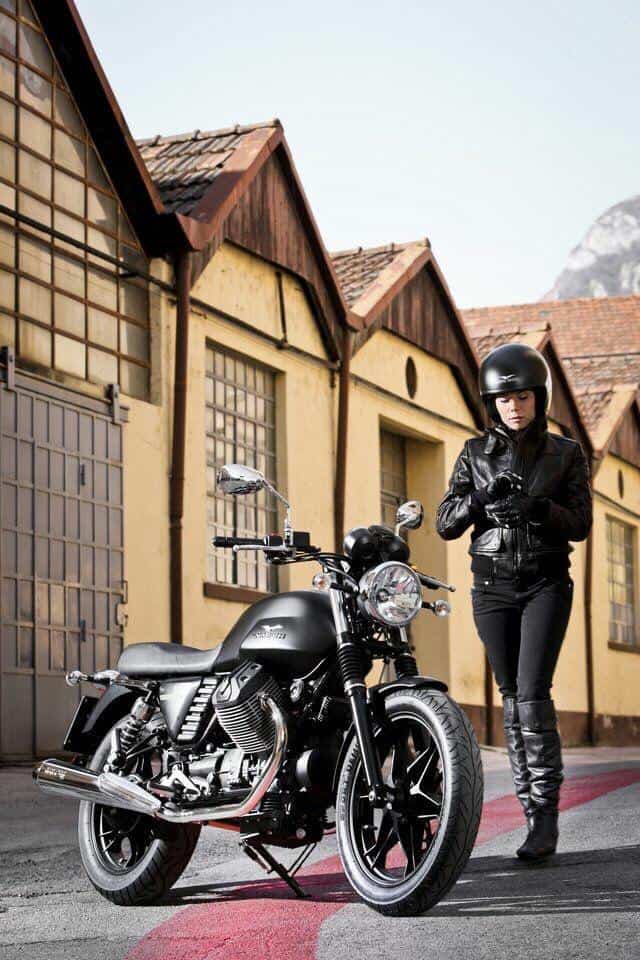
No matter what Brand, CC or color, Motorcycles are there to be ridden.
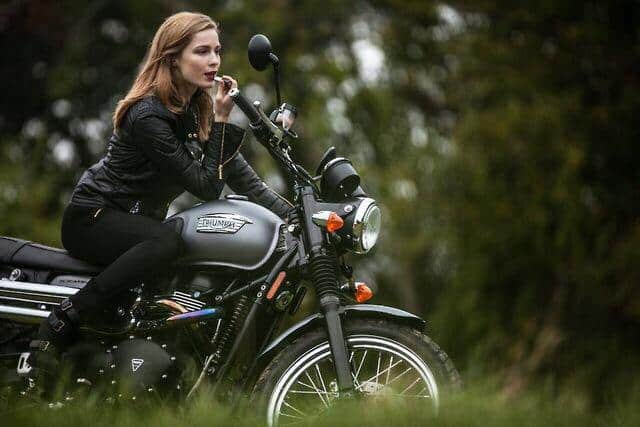
So lets see some photos later of you lot with your two wheeled mean machine and we shall post it on the website.
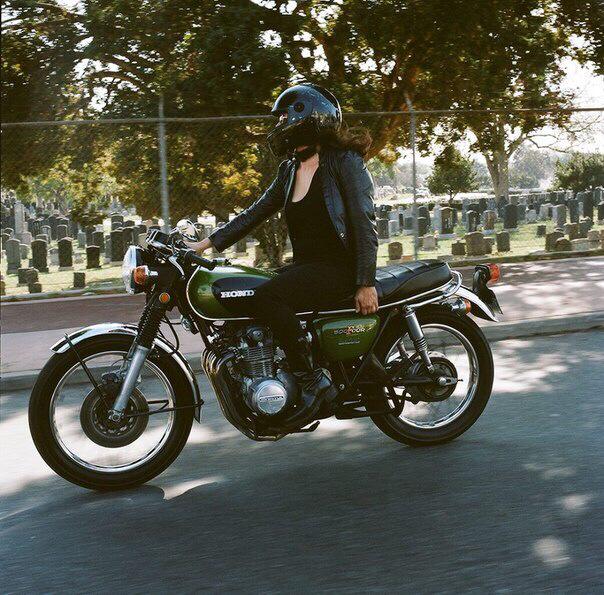
I know there are a ton of you out there, so lets get together and all go for a ride sometime.
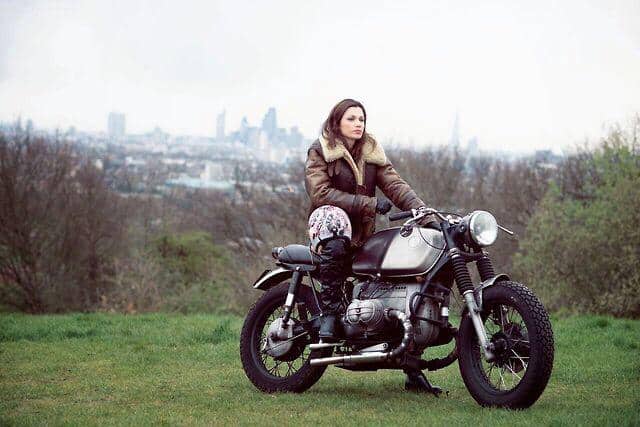
It can be Stock, Cafe Racer, Brat, Tracker, Chop, Custom or just a Vintage ride, its all good.
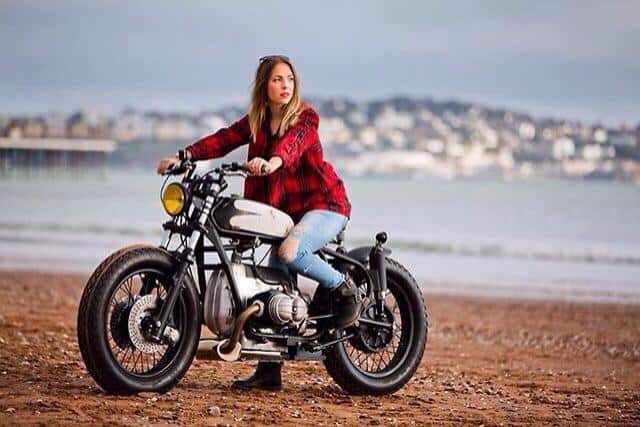
Have fun too, its up to you what you want to do.
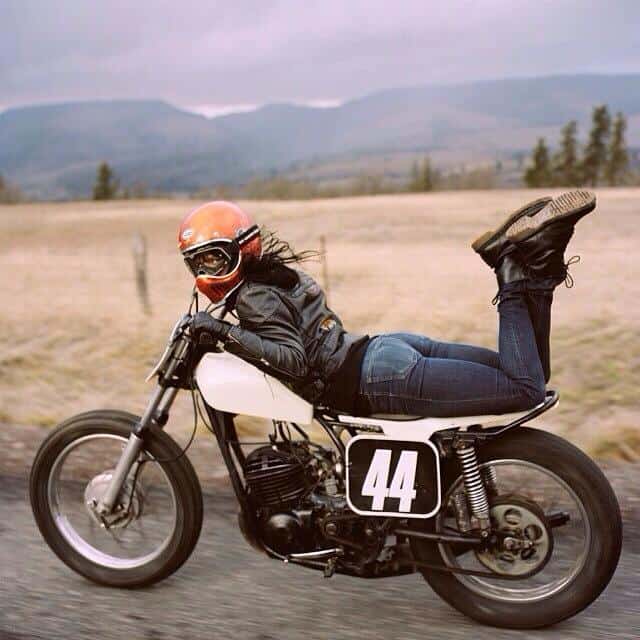
Its about having fun and relaxing, getting away from the mainstream of life.
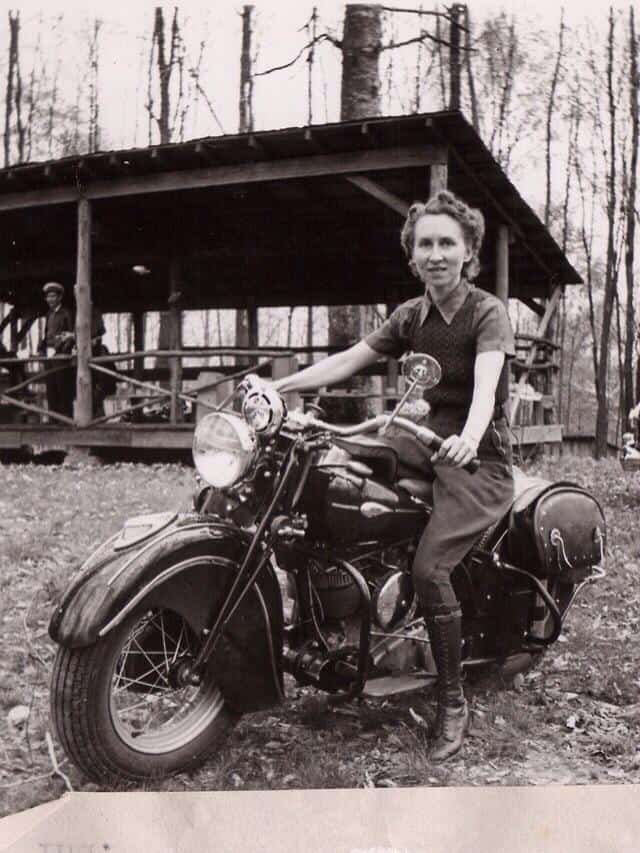
Love this photo of somebody’s Grandma on her Harley, very cool indeed.
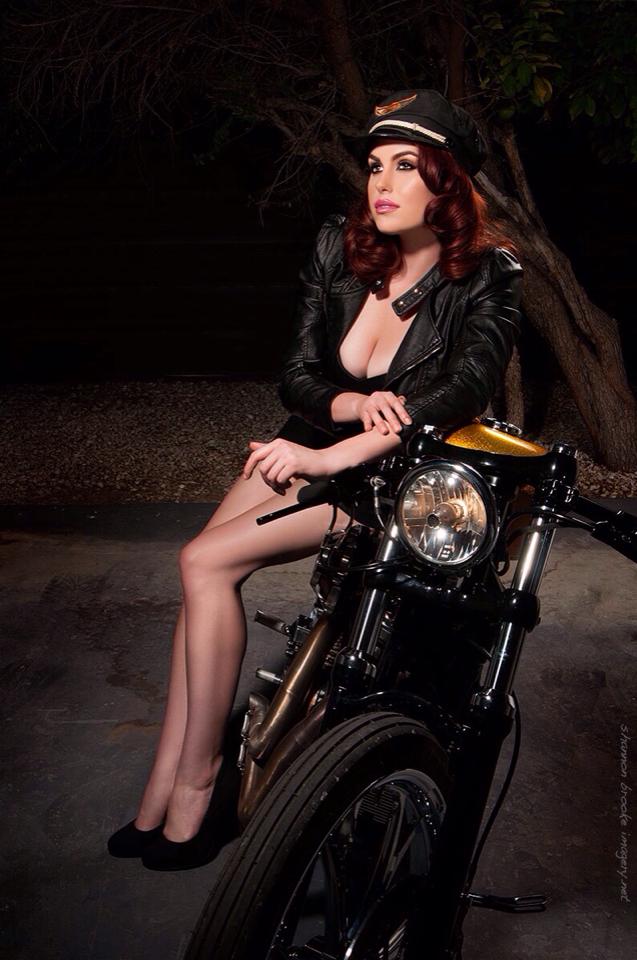
Be yourself and just enjoy the art of Motorcycles and the people that ride them.
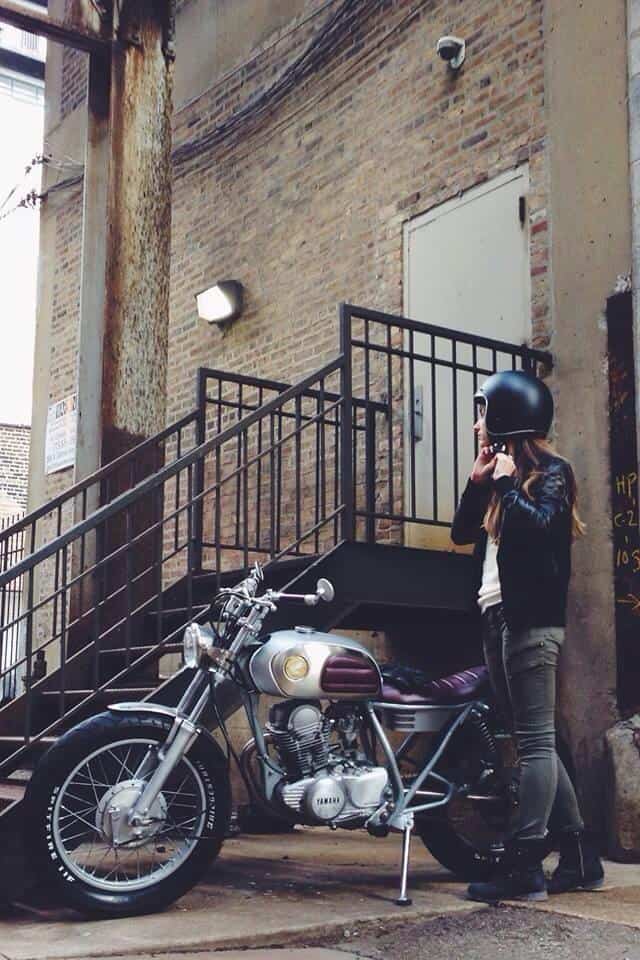
How cool is this Yamaha?
And Below, Pig Tails and leather, awesome!
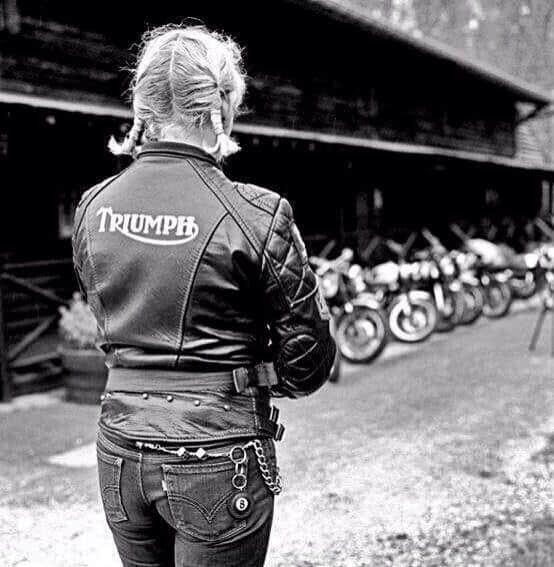
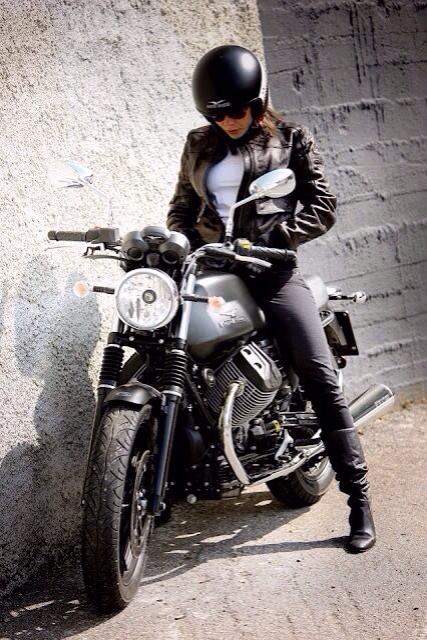
Get out there and show the world that you dont take any crap and you are in control of what you do.
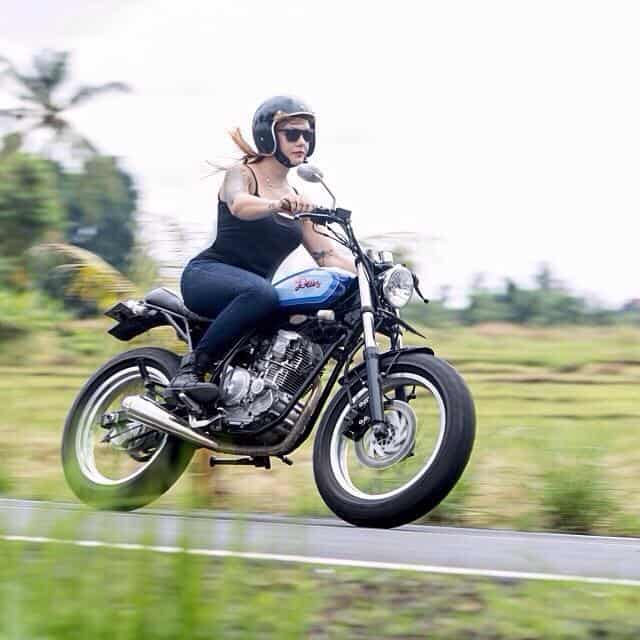
J
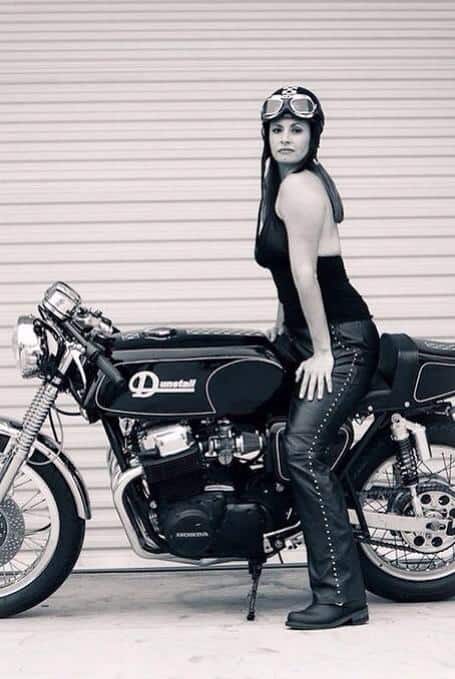

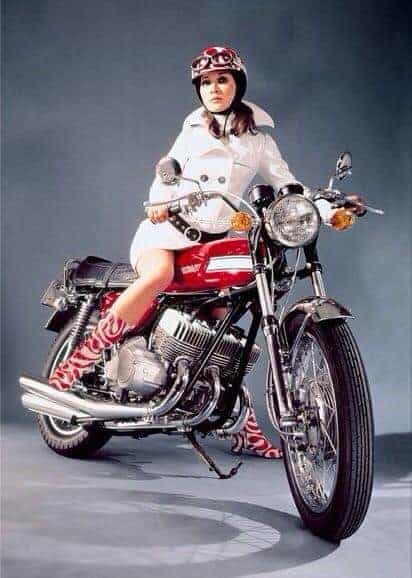
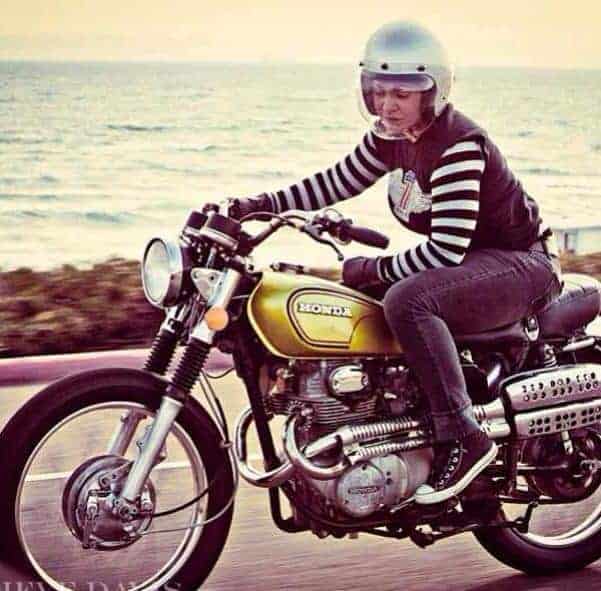
Here are some more shots I thought that you may like to see.
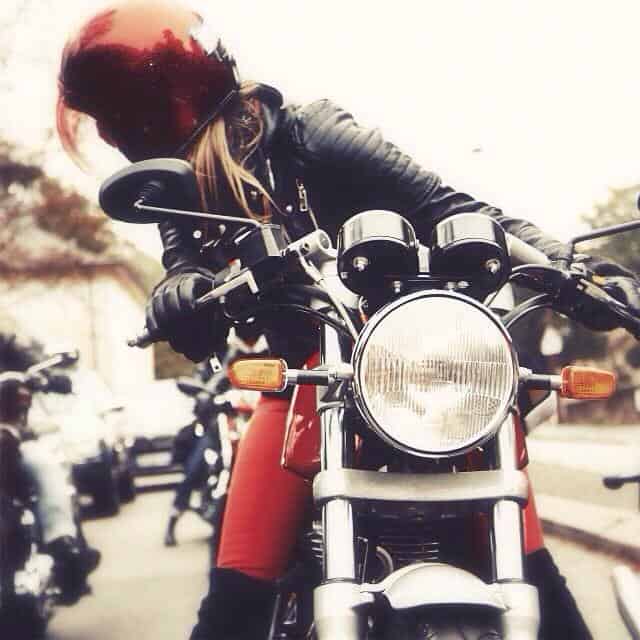

I dig the Harley Cafe back home in London and surrounding countryside.

Come on Girls, get on the Tarmac and have a blast!

All business thats for sure.
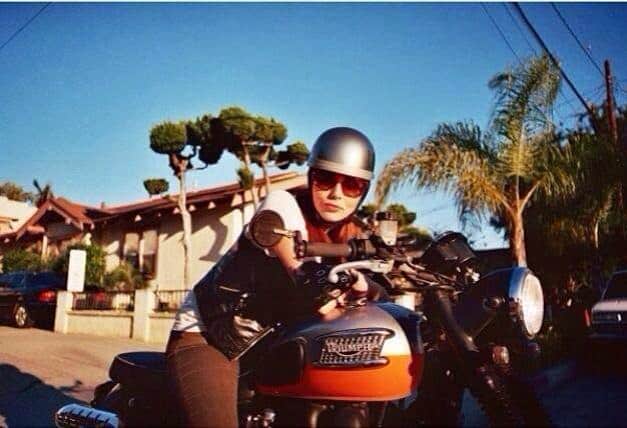
This is such a wicked shot, I have t admit Black and white really rocks.
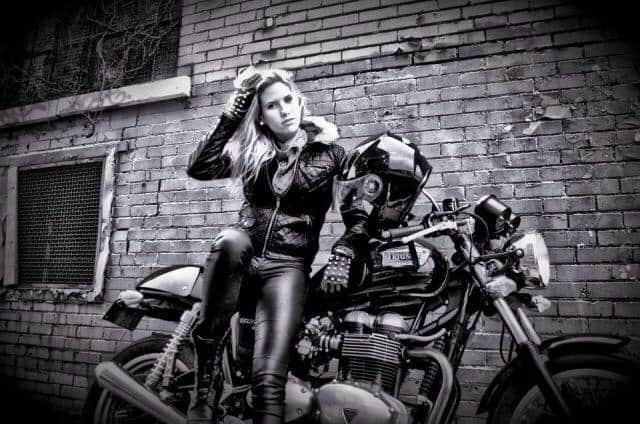
Thats it girl look back and all us guys were left behind, Brilliant.
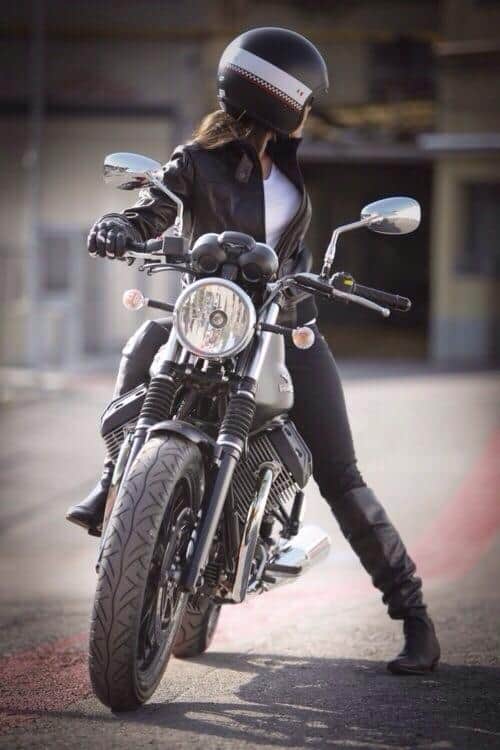
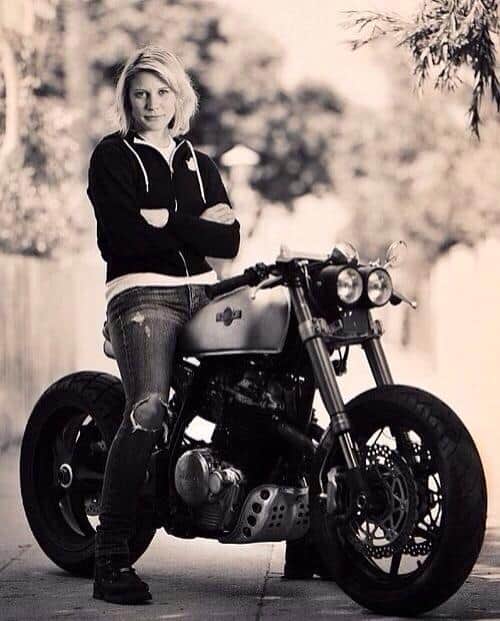
Some of these photos are timeless, send us yours as it will be great to share with others.

This little Yamaha is a cool Brat style very popular right now.

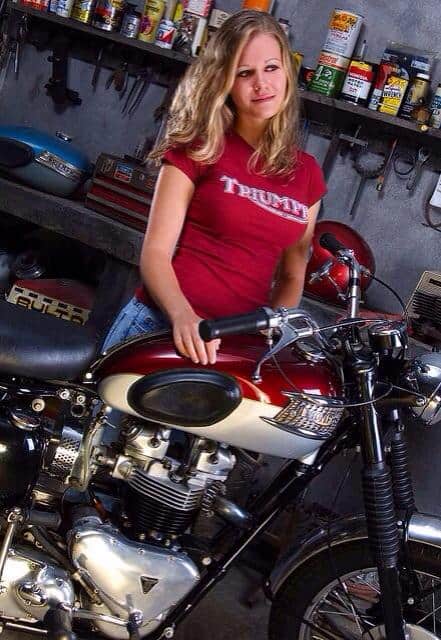
Be it a Triumph or Bmw, its all good.

Love this shot of the Girl with her Indian.

Looks like its time to ride.

Motorvating over the hill.

BRAAAP!!!!
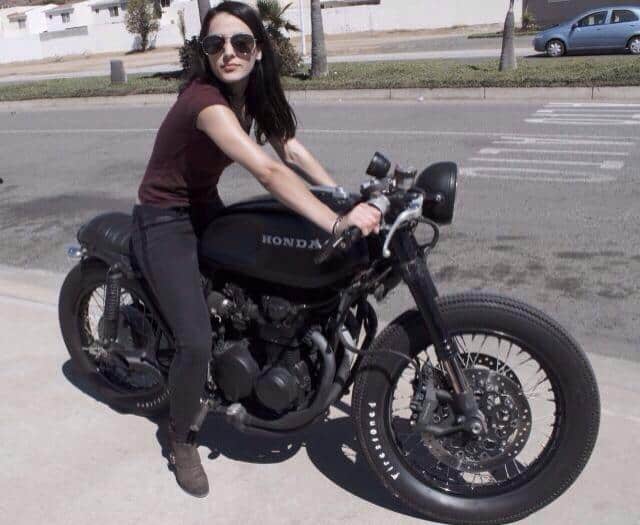
Thruxton are a good size bike and I have one and love riding it.
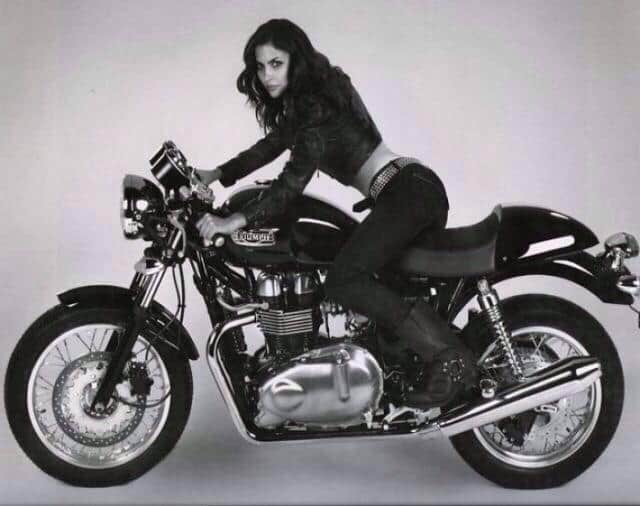
Superb Photo.
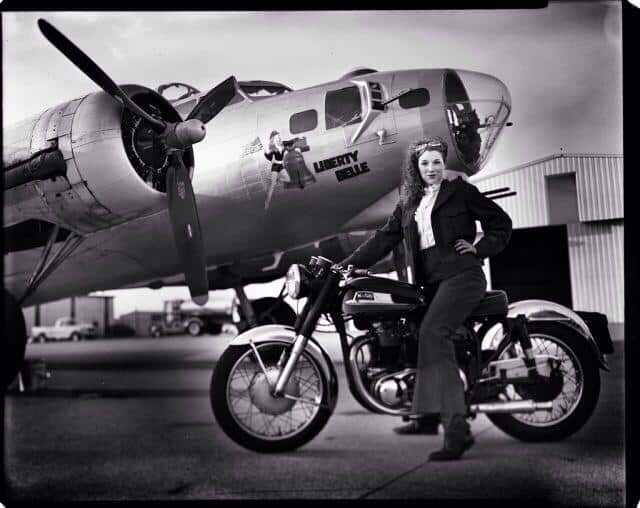
Ringa Ding Ding Dinga!
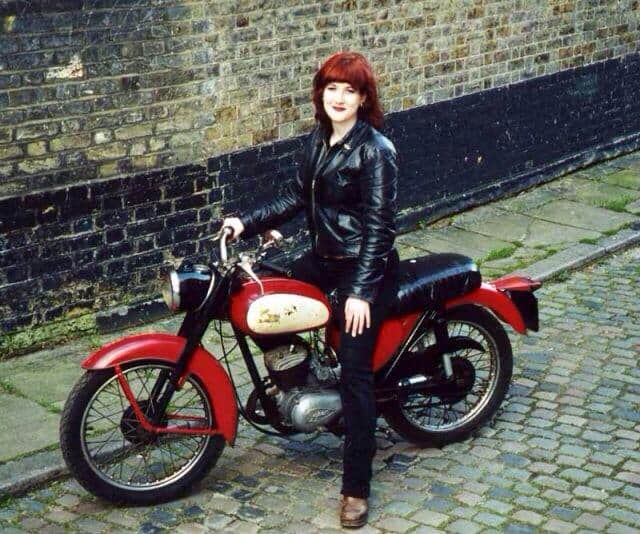
Hauling arse.
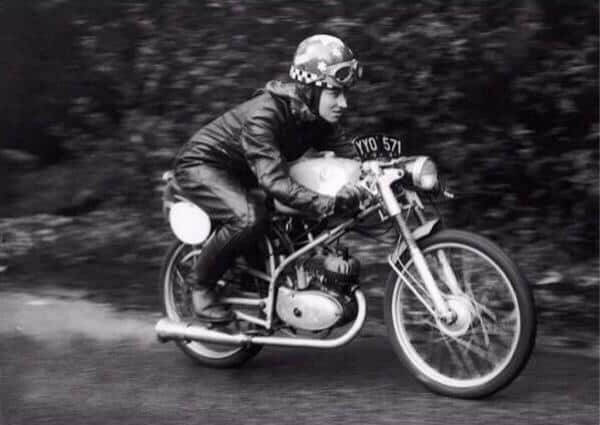
Norton looks great but Mum taking dad out to the Pub looks a blast!


Old meets new and thats what I love about the whole scene.


Some more great shots of Girls om Motorcycles.
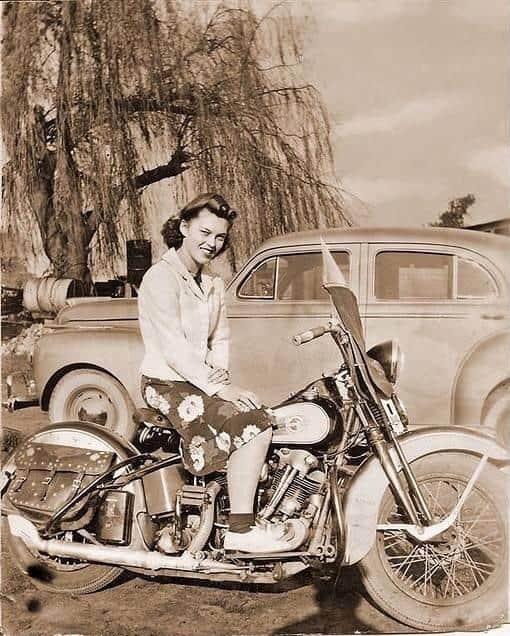
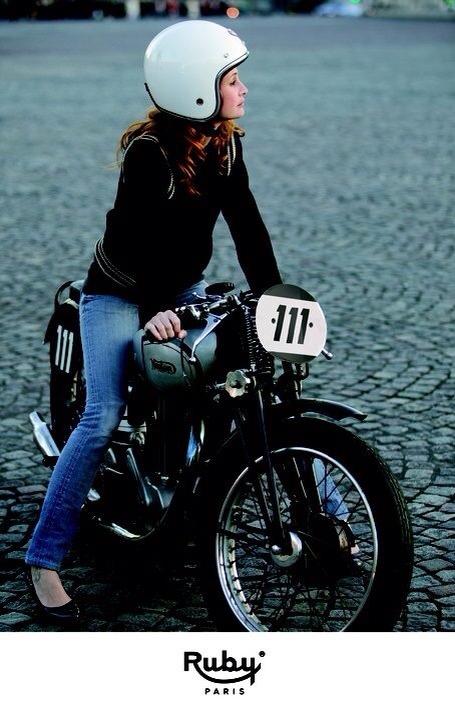
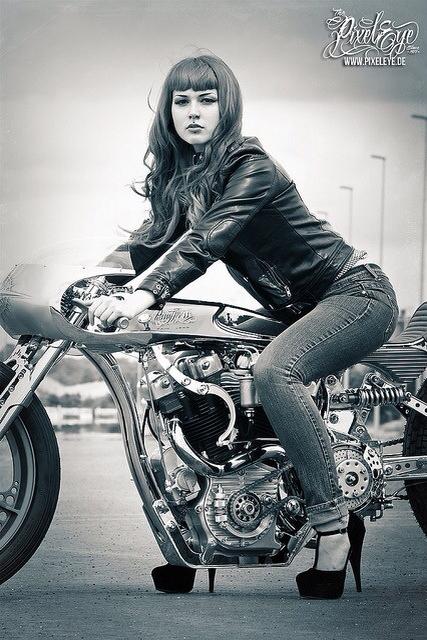
The little CB200T is a great bike to use around town and super fun to ride.
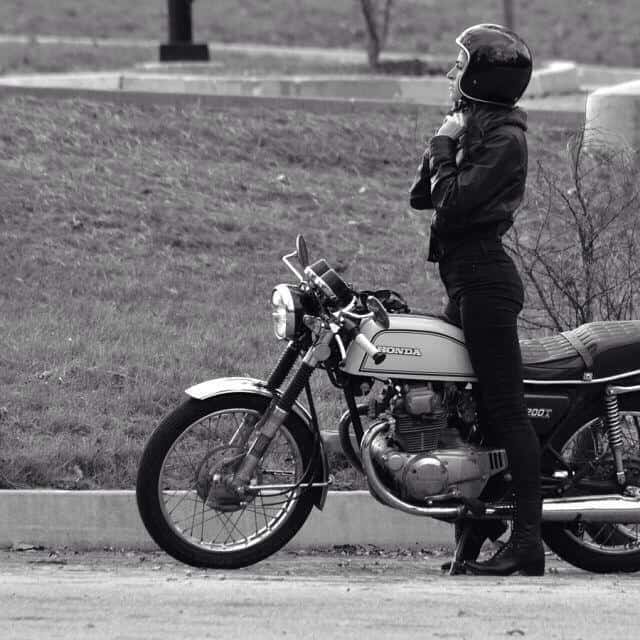
This Girl shows off her balancing skills before she rides the wall of death.

Plenty of envious people looking at this for sure.
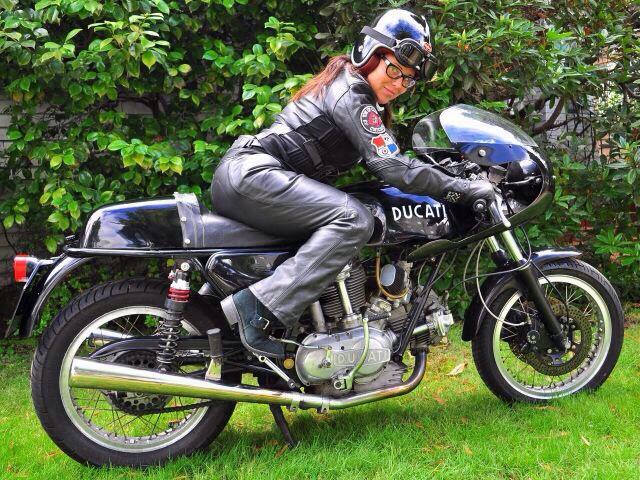
How cool is LIFE magazine showing this?
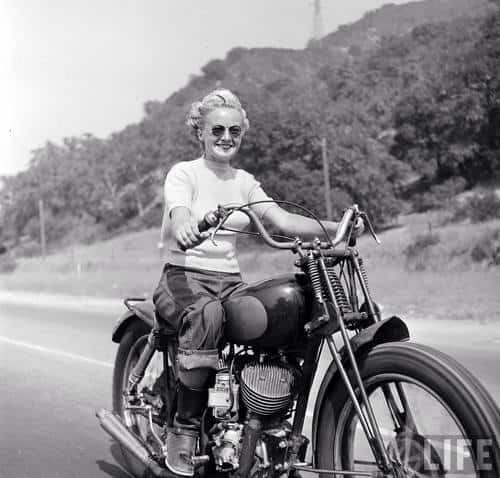
Below, now thats a Cafe Racer Motorcycle.

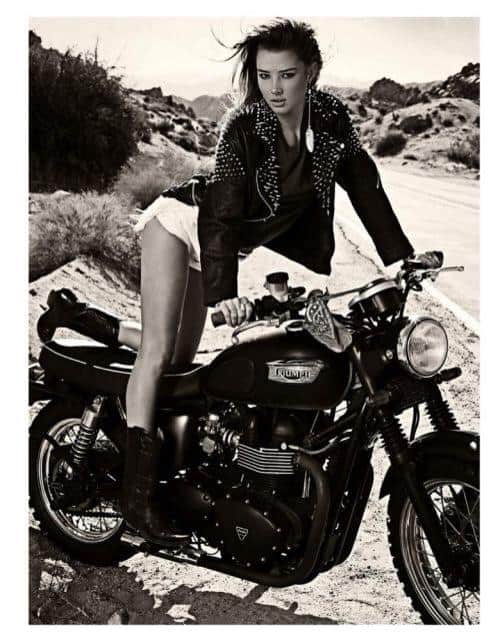
How super cool is this photo and wearing all the great Vintage clothing back when it was New, love this shot.

Somebody means business on the Tarmac in both photos.


Todays style is a great one ad a great photo graph taken.

Girls having fun on their rides, I would love to see this a lot more.
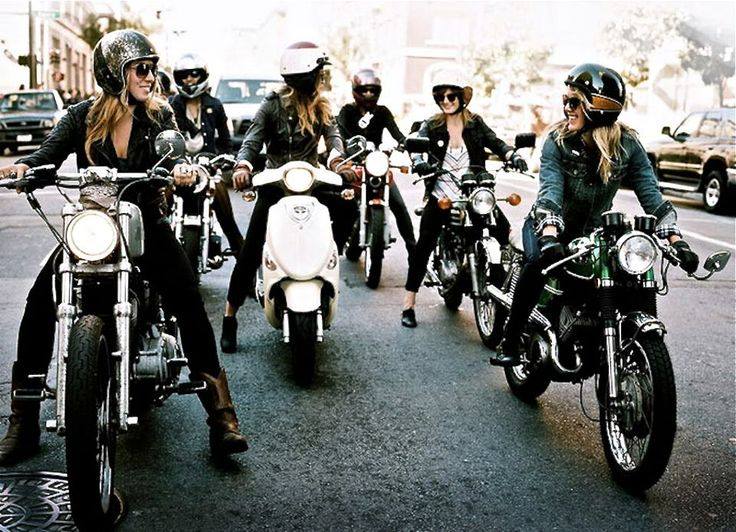
Watch it boys, this Girl will beat you at any traffic light.

Below is some other shots I have found and added but if you have any of you and your buddies, just email them to us to share.
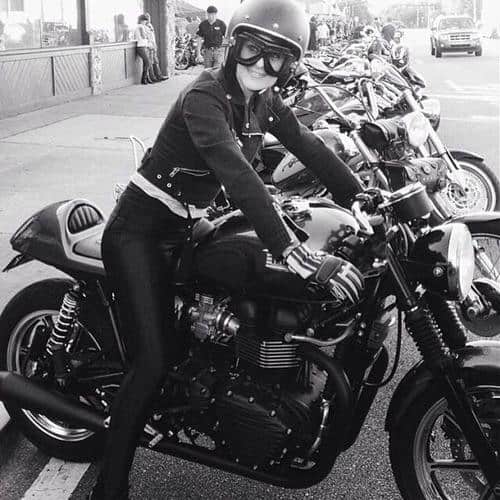
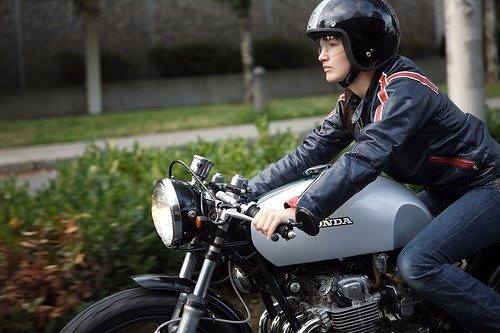
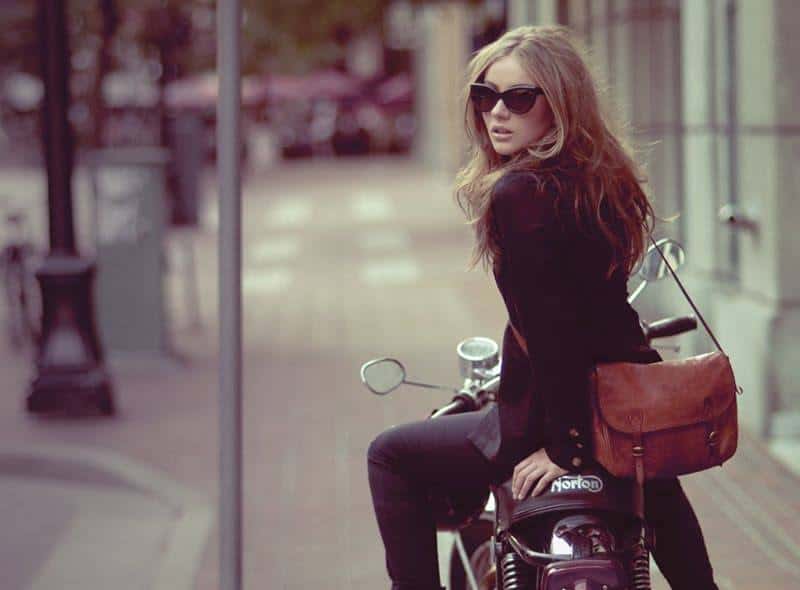
Yeah, I can ride too!
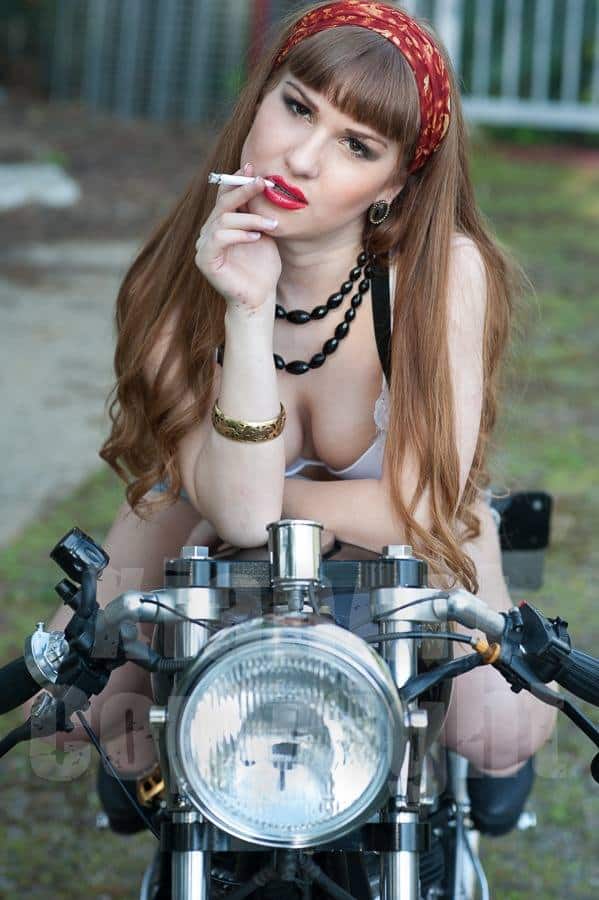
Two great photos here.
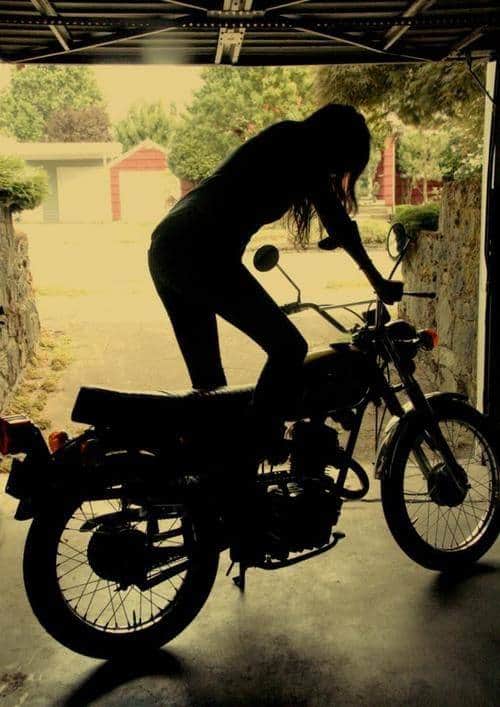

Custom Triumph looks great under the Bridge.
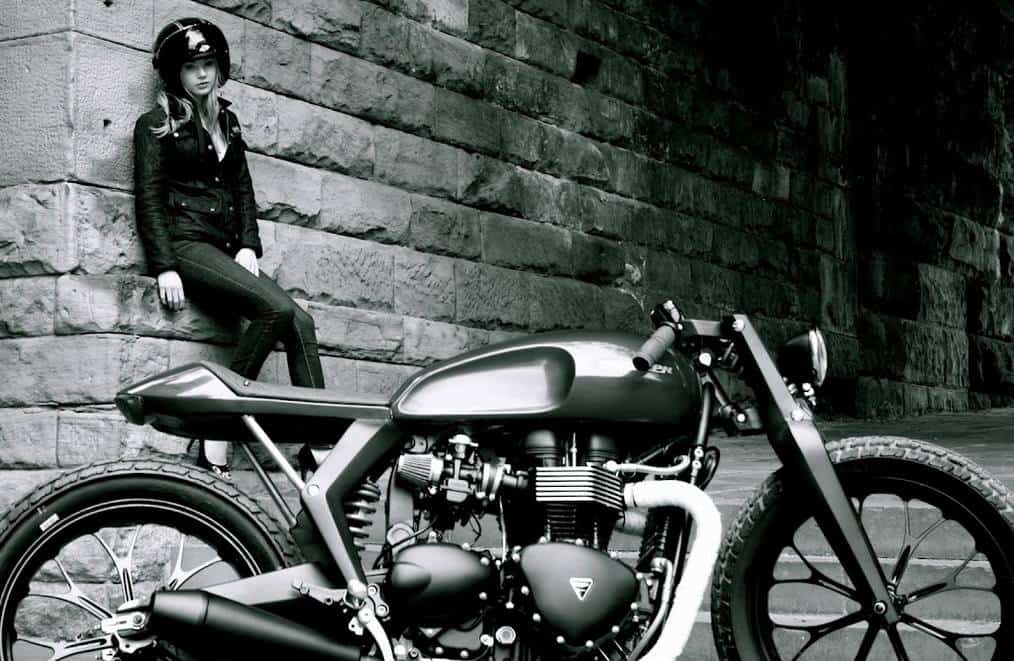
She means business for sure wit that Liz Hurley look.

Old School.

OK- its on, lets ride!
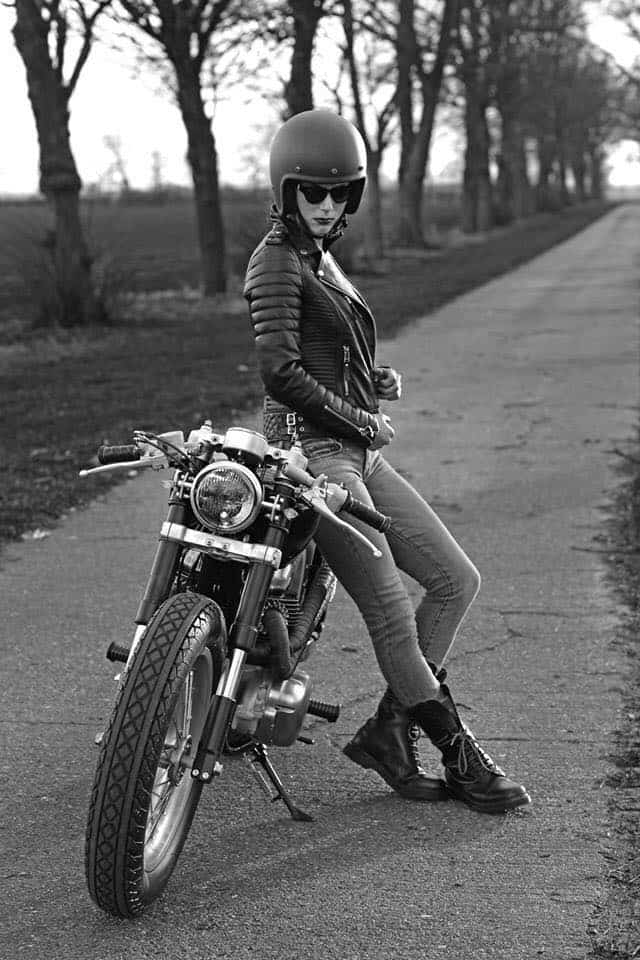
Tickling the carb and then fire her up, she knows how to start a Brit bike alright.
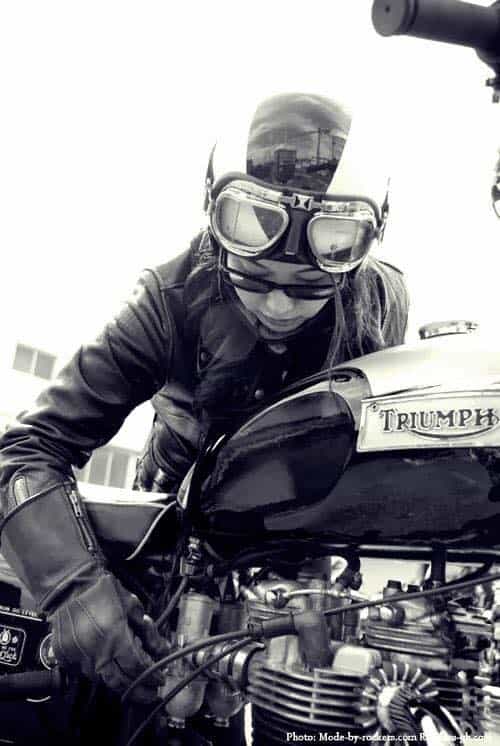
Cruising and in the rain, awesome stuff.
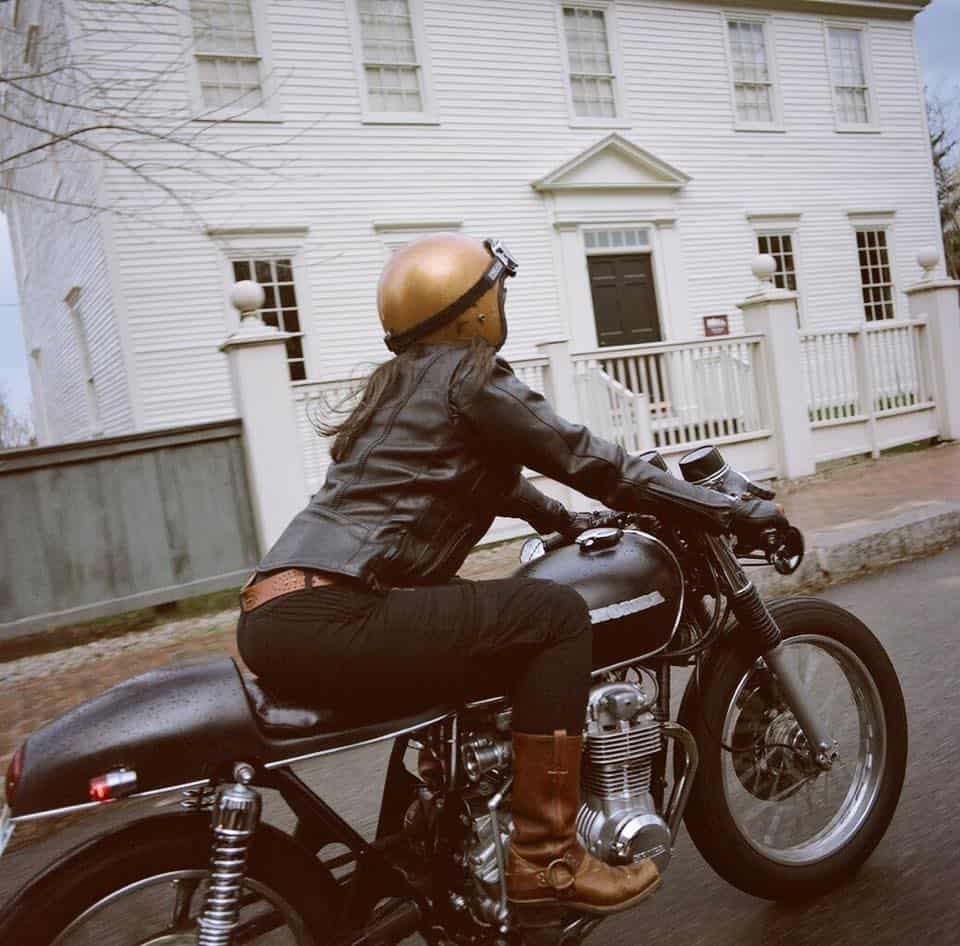
Countryside Cafe back home in the UK.
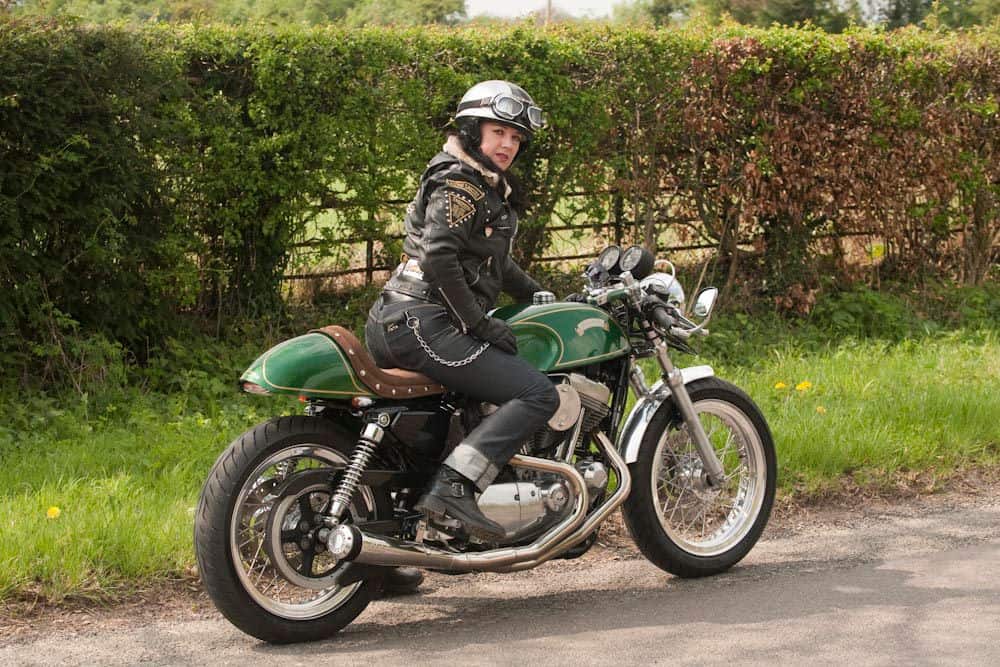
Leopard and leather, cool concept.
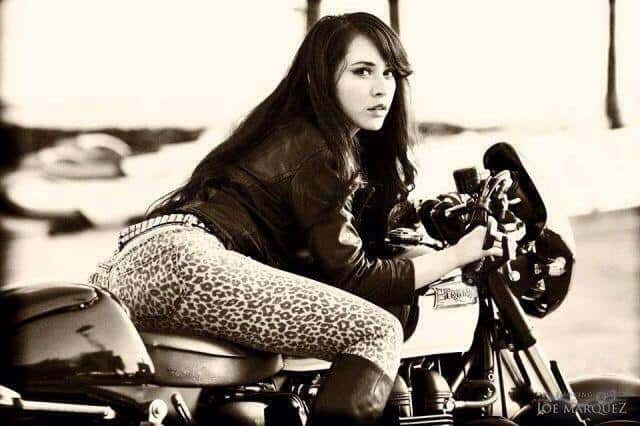
Warming her up so she can show the boys how she gets around the bends.
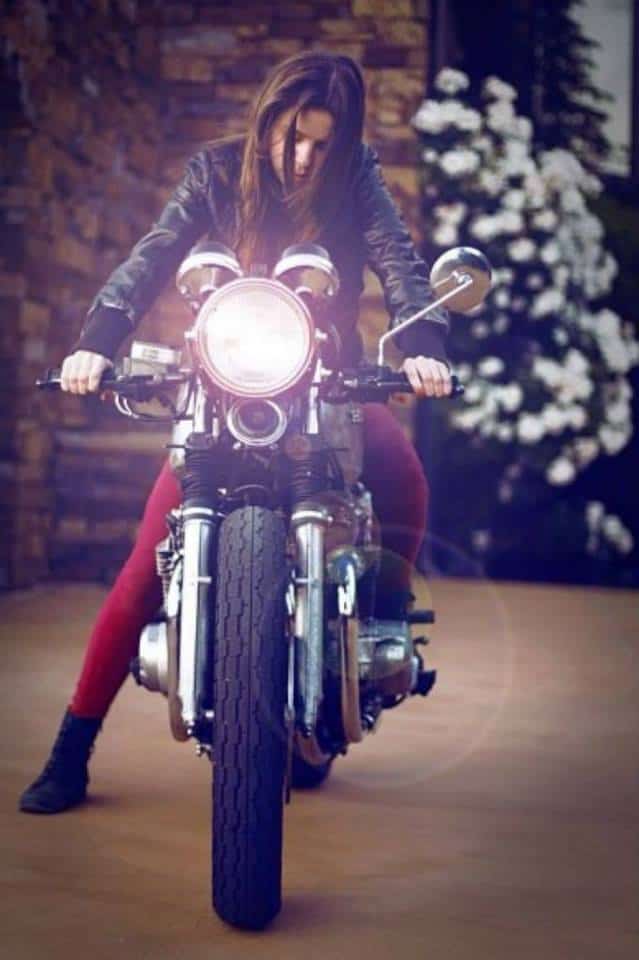
Still, there is always time to make sure all is well.
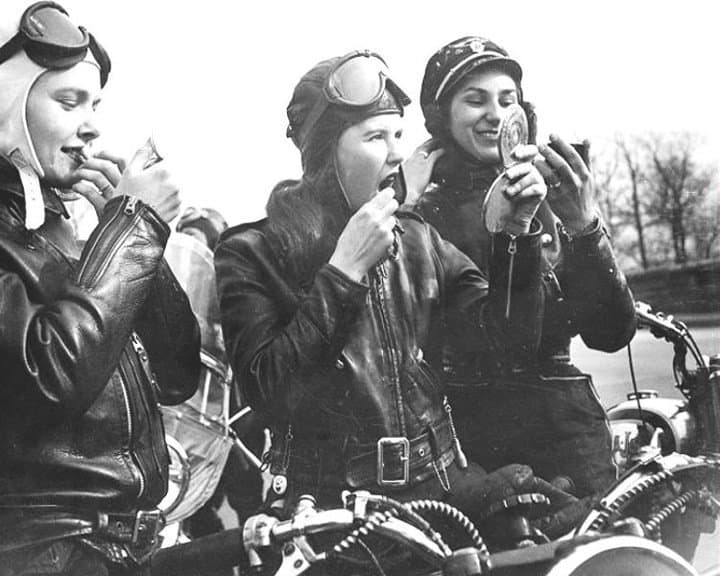
Waiting for the lads to turn up, boy are they slow today!
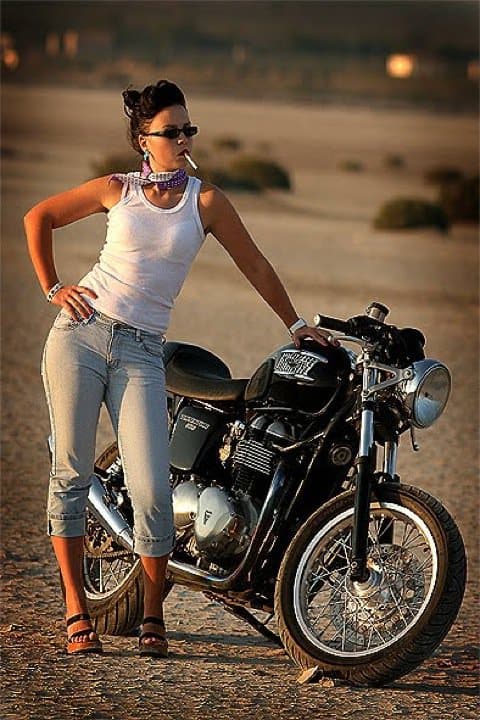
This Girl has been riding for many years back home and always looks cool.
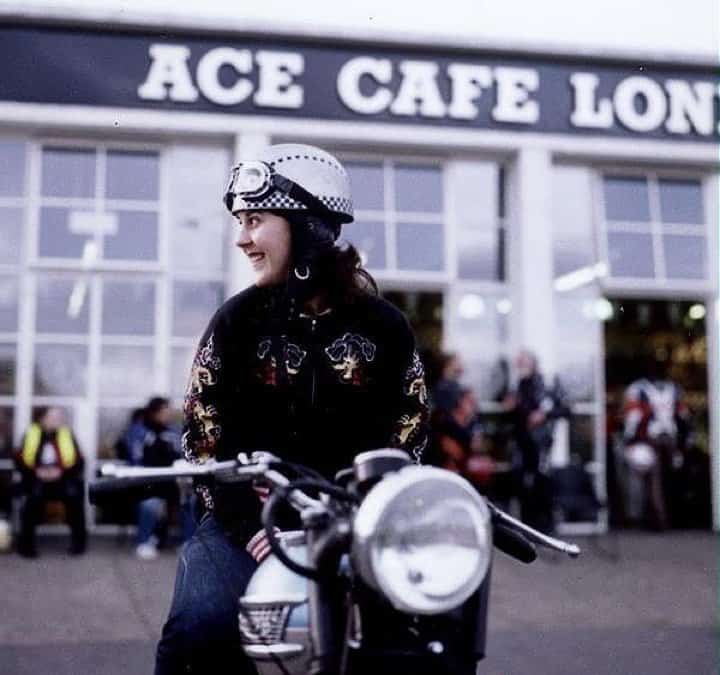
Nostalgia is so big and this photo looks so original.

That is one tough looking machine.
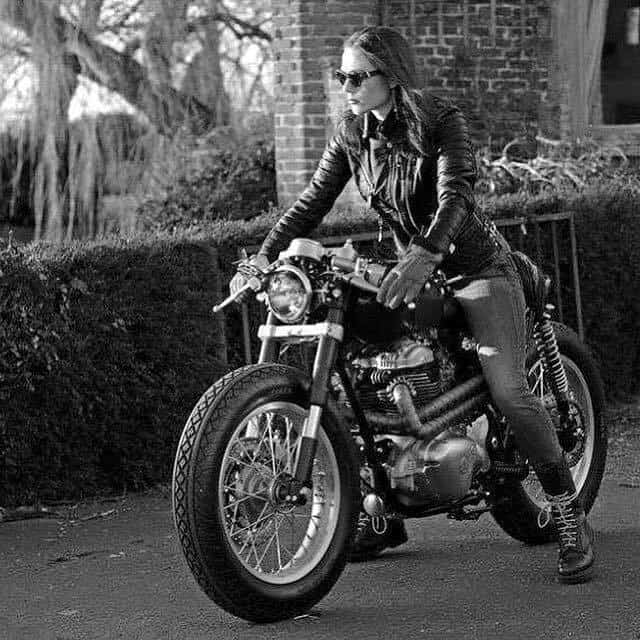
Looking sexy on a CB750 Four.
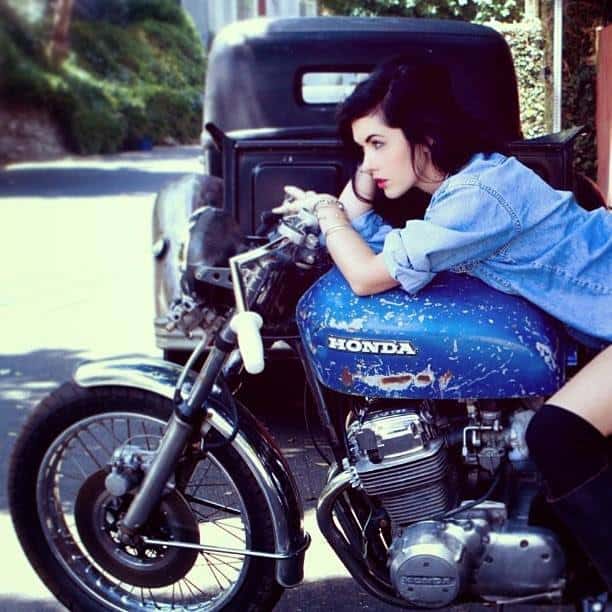
How tough is this, all fully loaded too.
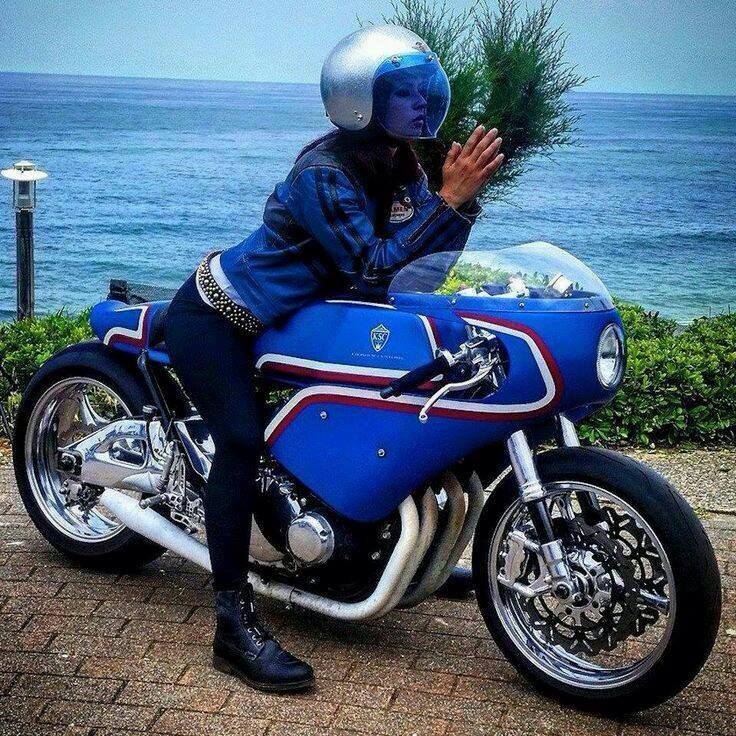
This Girlie not only rides but builds show winning machines.
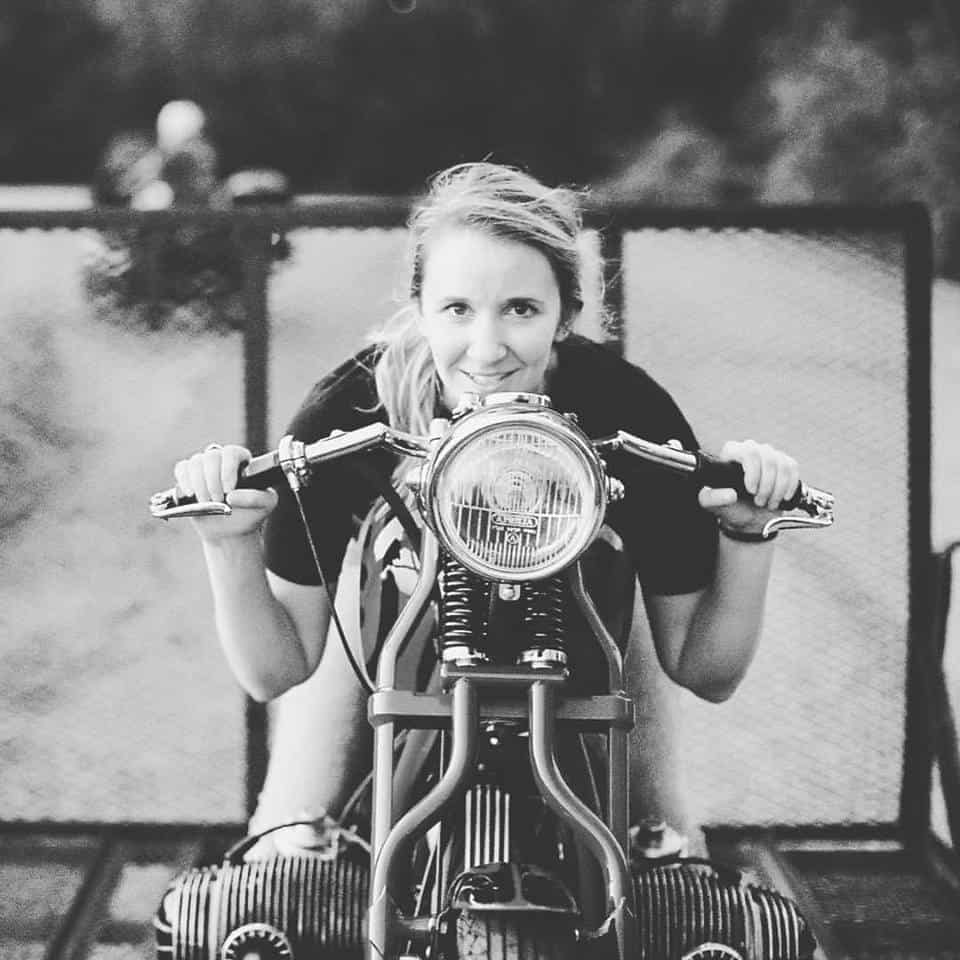
Here she is on another cool cafe she designed and created.

Super Nice Norton.

I really like this shot.
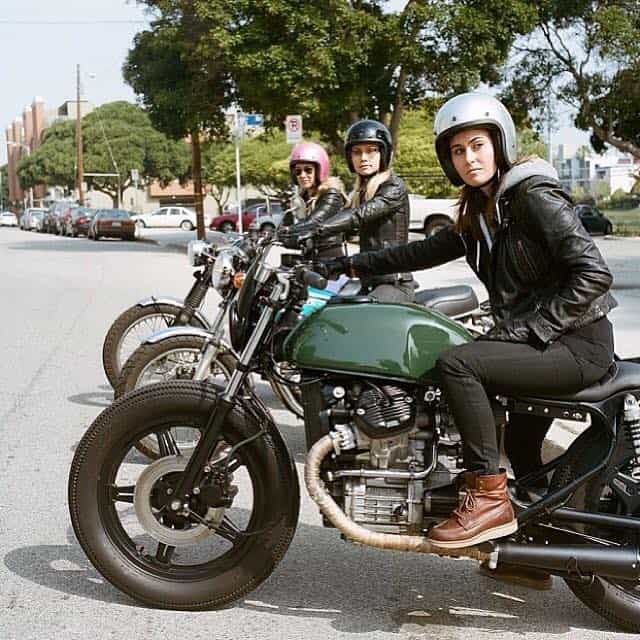
Come on Boys lets ride!!!!
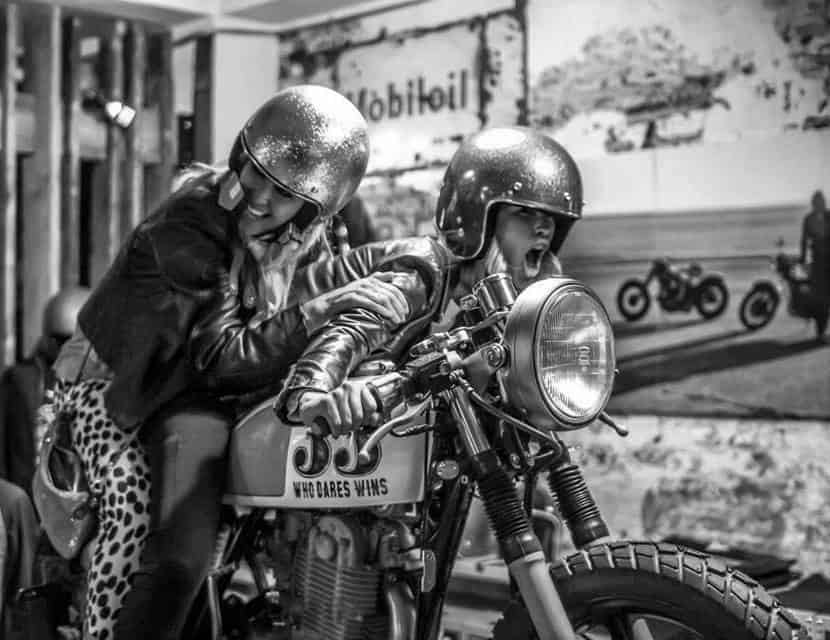
I love this French Built Trumpy.
I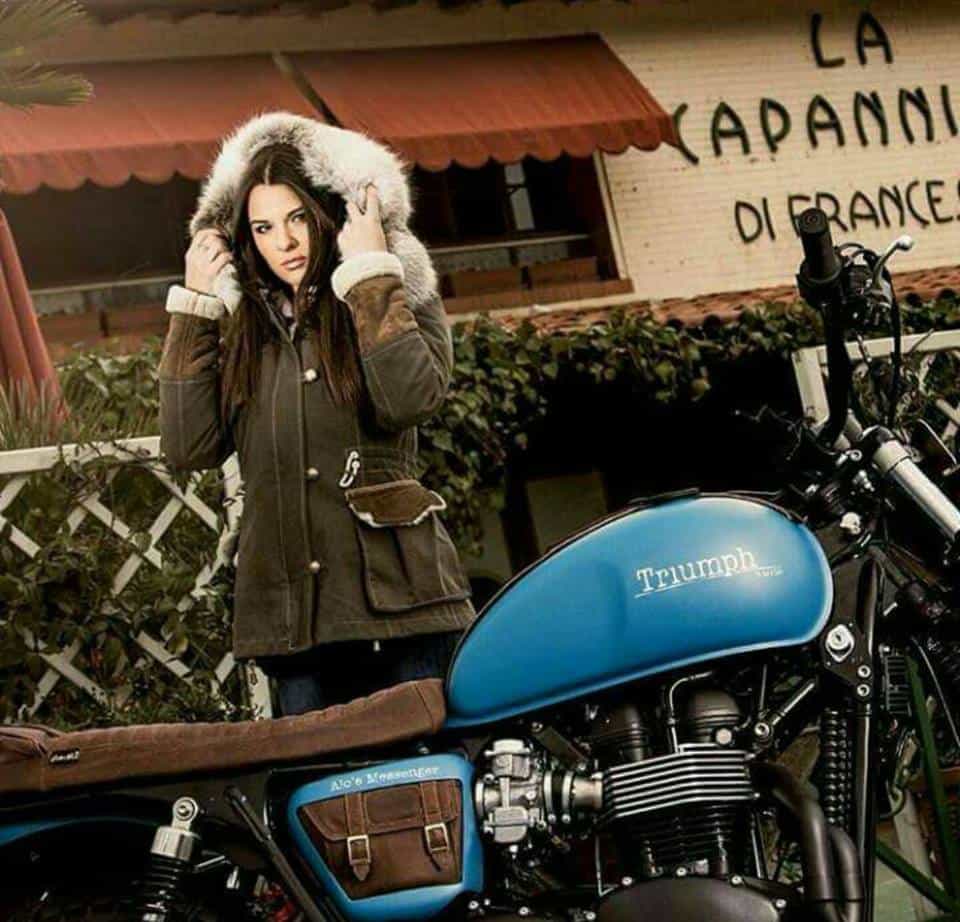

Wig Wam cafe racer gets ready for its very own pow Wow!
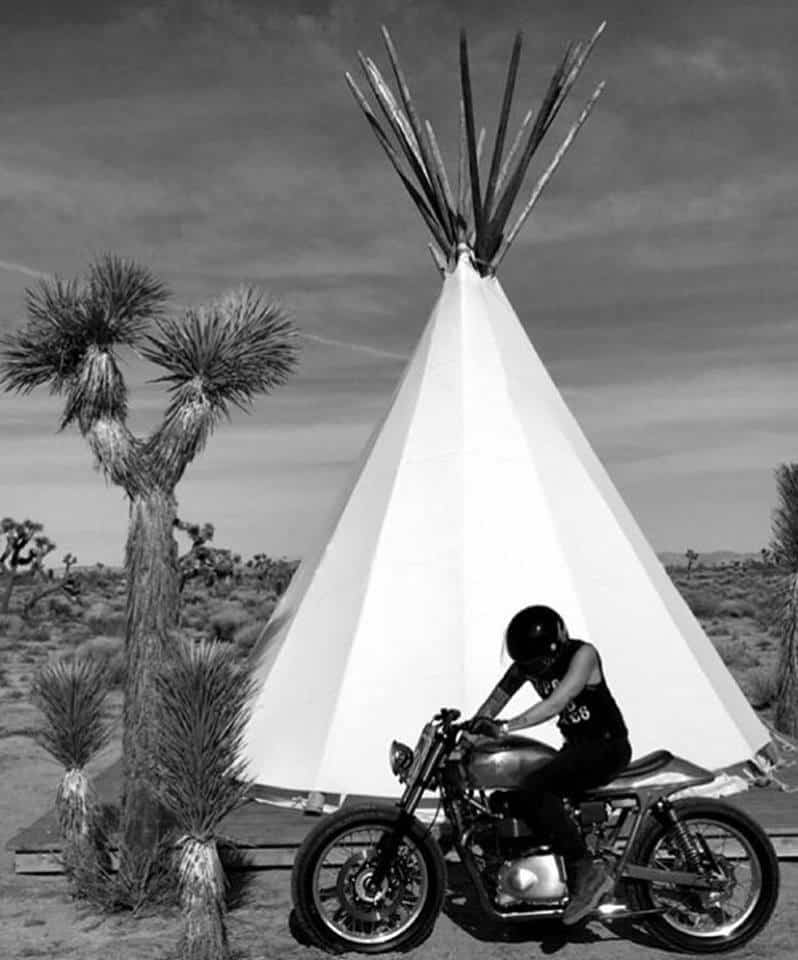
On the count of Three…1…2…..
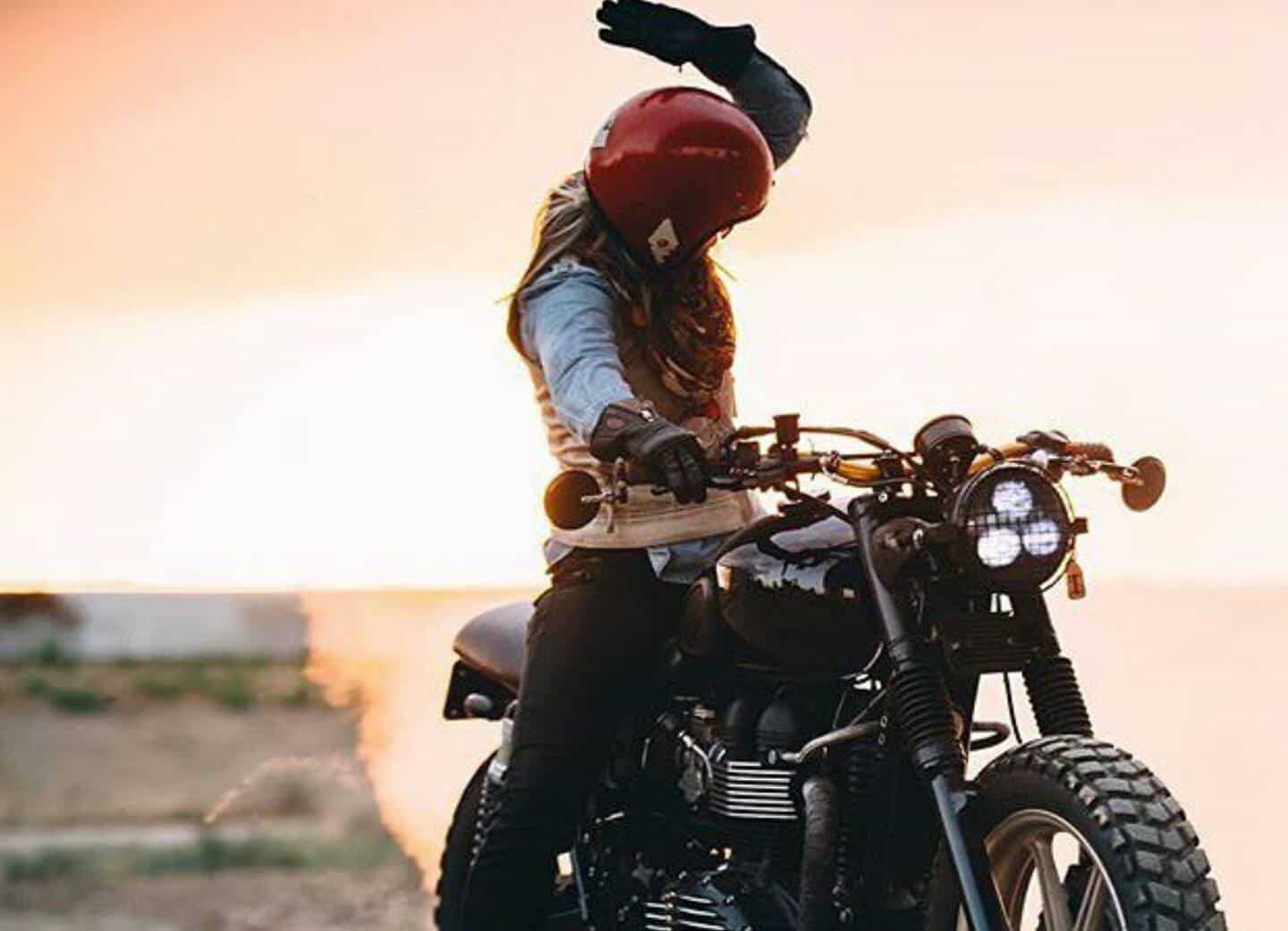

What is softer, the leather seat or the Leather jeans, answers on a postcard to….
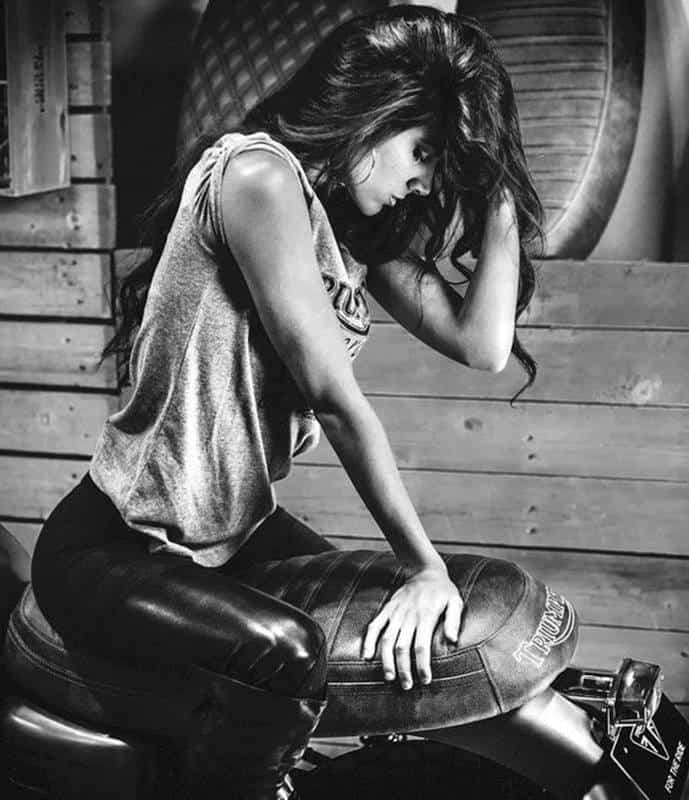
Of course I love this photo, whats not to like about it.
Sean Capshaw @ Resolusean Photography and their website is:
Model is: Chelsea Middlebrook – http://www.theimagesolution.com

Fired up and getting ready to go out for a ride.

Great shot of this Girly on her Trumpy!

Such a stunning photograph!

This Girl reminds me of my Girlfriend Jennifer.
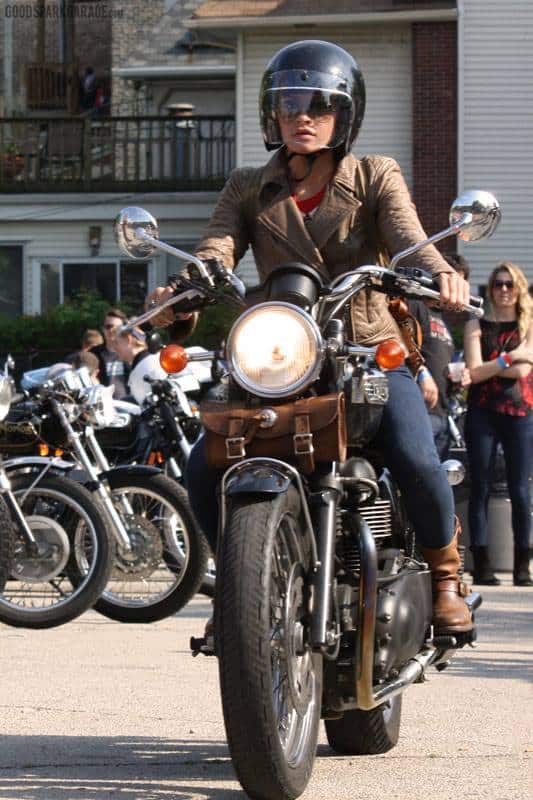
Back in the day and a rare shot too on this Tiger.

I bet this turned all the boys heads as it did mine.

Yaaah! Time to ride with the 59 Club OC.

Looking on in a really cool Belstaff Jacket.
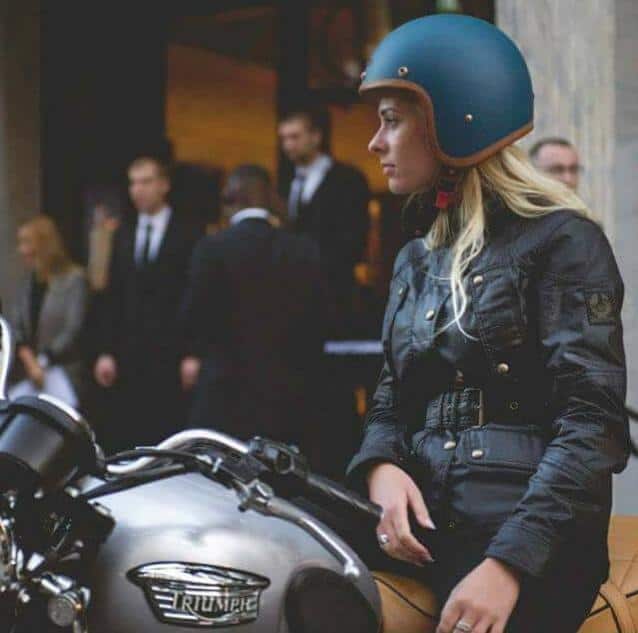
OK, last photo but she is heading out to meet her friends and we sure hope we get to meet some of you.
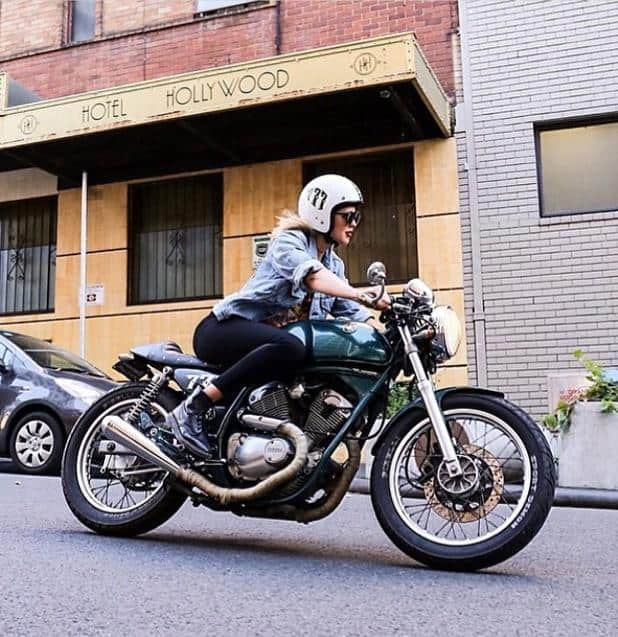
Thanks for looking.
Please send any information about these images to me as there was no credits to the photo or model, as i want to give them the recignition that they so truly deserve.
BUILDING CAFE RACERS IS THERAPY FOR THIS FIREMAN
Serving 20-plus years in the Fire Brigade, Bryce Mitchell-D’raine has experienced more emotionally and mentally challenging situations than most, and building Cafe Racers is just one of the outlets for the Western Australian to distance himself from the day-to-day hustle.
“With my work, we see a lot of guys with mental health issues from what we experience, in terms of post-traumatic stress,” said Bryce. “To me, it’s therapy. With my career in the Fire Brigade, it takes me away from the stuff that I deal with at work.
“It gives me an opportunity to come out, sit their and work, and think about something that I love doing. It’s the same when I’m in the water surfing – it’s great, it’s calm, there are waves and you’re having fun with your mates.
“Building the bikes, it’s the banter that goes on – mates come out, you might be doing something on their bike or you take the bikes out for a run when you’re finished.
“It’s just getting together and getting away from the mundane and harsh life of working in a career. It’s a really stressful thing these days – we don’t have the opportunity to switch off.
“Our parents would come home and switch off from it all, but you know, they weren’t constantly being bombarded with stuff on TV and social media. I think having something where you can take yourself away and sink yourself into is really important.”
Riding motorcycles since he left home in his youth, Bryce has always had an interest in building custom bikes, prompting him to take on his very first build four years ago.
Bitten by the bug and attracting interest from the local Cafe Racer scene, it ultimately led him to start Divine Proportions alongside his brother in law Pete.
It’s a side business the duo have been operating out of a plumbing workshop, building custom bikes to their flavour that are later put on the market. Most notably, with the help of numerous enthusiasts, Divine Proportions completed a charity build for the 2017 Distinguished Gentleman’s Ride, raising over $6,000.
“It’s funny, Divine Proportions started off between my brother in law Pete and myself. We were sitting around drinking – as most stories start out. Pete and my other brother in law Nick wanted a bike too, so I was like we should start up a little group and call it something.
“It started off as DP, which didn’t stand for Divine Proportions at the time [laughs], but yeah, the Racer TV dude always goes on about the divine proportions, we thought that stands for DP as well, so we went from there.
“The Distinguished Gentleman’s Ride supports men’s mental health, and also cancer – they’re two things that for me, they’re really close to home. I’ve had mates in the Fire Brigade that have had cancer, and like I said, we see a lot of stuff in our job, and it does affect guys – it’s quite accumulative.”
12 STEPS TO BUILDING A CAFE RACER
12 STEPS TO BUILDING A CAFE RACER
THE FIRST FEATURE on ‘How to Build a Café Racer’ struck a chord. Not everybody who read it agreed with the content, but when it comes to style, there are several different schools of taste.
I’m going to focus on the performance side of building a cafe racer. Or street tracker, scrambler, or any custom motorcycle, for that matter. Let’s start by picking the right bike up front to avoid expensive mistakes down the track.
1. Choose your weapon. The most affordable motorcycles to customize are the bikes that time and style forgot, and many are Japanese. That means the Honda CBs, in the 350, 360, 500, 550 and 750 capacities.
Yamaha has the XS series, in 360, 400 or 650 capacities. Forget the XS500 or TX500, unless you’ve got tons of time and money. Then there’s the SR400 and SR500, and even the Viragos are now getting lots of attention.
From Kawasaki, you can pick a Z of any size. But it was Suzuki that produced some of the best air-cooled inline fours, like the GS750/1000s—which is why Pops Yoshimura gave them so much love. And why you see hardly any for sale these days.
2. Know the issues. All these bikes will most likely have the same issues, because they were all manufactured at least 30 to 40 years ago. We’re talkin’ about the 70s, when bikes were gaining power with each new model year but the handling was lagging behind.
By 1972-73, almost every bike was sporting a disc brake up front. Intake noise was still audible, and most wheels had wire spokes. Shocks were mostly chrome spring holders, and low-hanging mufflers and centerstands caused lots of sparks (and crashes) when cornering at speed.
Lessons were learned and improvements were made. As the bikes were pushed to their performance limits at the racetrack, improvements gradually made their way into production models. These lessons, tricks, new parts and tuning secrets have since continued to gather, so we now have a huge pool of knowledge.
I should mention it’s always a good idea to choose a bike that has decent parts availability—plus a wide selection of aftermarket goodies. Putting a lot of effort into a bike that you can’t even buy a head gasket for is the start of a frustrating journey.
3. After your purchase. Let’s say you bought a 70s bike cheap, with the intent of building something really cool to dazzle your friends. Maybe you’ll ride it every day to work or school too.
After many nights in the garage, the bike runs decent and you’ve done all the things that everyone else does to make your bike look cool. But you’re starting to think, “Wow! This thing is like a slow, wobbly 40-year-old buckboard.”
When you go for a spirited ride in the hills with your friends, maybe the bike isn’t all that exciting or confidence inspiring. Or it’s just plain unsafe. Or maybe there are a couple of guys with bikes from the 80s or even the 90s disappearing over the horizon. You’re thinking, “It’s got to get better than this!”
Unfortunately, bikes have been improving at an exponential rate over the past thirty years. But you’re committed to riding your 70s bike, and want to be able to say you built it yourself. It’s time to improve it, while keeping a realistic view of how much you can improve it before you’ve depleted your resources.
4. Make a plan. You’re gonna need a few things. Starting with a direction and gathering knowledge is a must. What can you afford? What should you do? How do you find out, and whom can you ask?
If you search the web and look at pictures of 70s racing machines and hotted-up street bikes, you’ll find clues. The stance was usually changed, as were the tires. Aluminum rims replaced steel, and generic aftermarket shocks and fork kits were installed. You often saw braided stainless brake lines and a second front disc and caliper. Frames were heavily gusseted, and so were swingarms—or they were upgraded with aluminum items.
In the engine/performance department, you’ll need to dig a little deeper: Pictures will show only the external mods. You’ll notice air cleaners, bigger and better carbs and exhausts, and perhaps some sort of oil cooler. To get an insight into internal mods, you’ll need to read articles from old magazines that have hop-up tips pertaining to your bike. And then look for those parts at swapmeets or on eBay if they are no longer manufactured.
Another way to gather knowledge about the older models is to attend a vintage race or two. There are classes for all displacements and different eras. The rules are generally intended to keep the bikes period correct, but most of the parts needed are readily available.
5. Get to work. All bikes like Honda CBs, the Yamaha XS and SR series and Kawasaki Zs can be improved with a standard group of upgrades, beginning with the chassis. Inspecting the frame for cracks or damage is the first step.
Factor in tapered steering head bearings or, at the least, replace the worn out stockers with new OEM bearings and races.
Most of the older bikes came equipped with a plastic swing arm bushing. This should be replaced with a needle roller bearing kit in solid bronze or new-old-stock ones.
Another area of concern would be the swingarm pivot shaft and reducing the side-to-side play of the swingarm down to the factory minimum spec. Up and down movement should be without restriction, but side-to-side or axial play should be almost nonexistent.
6. Spend on suspension. It’s time to cut loose. Namely, new shocks and a fork kit. Getting shocks from Öhlins, Racetech, Works Performance, Hagon or Progressive Suspension can all be an improvement.
That said, it’s absolutely critical that the dampening and spring rates are matched as closely as possible to the weight of you and your bike, taking into consideration what type of riding you’ll be doing. Buying a name brand shock that’s mismatched, already used, or designed for a race bike may not yield any improvement whatsoever.
I know that Racetech and Works will build shocks to exactly fit your needs. Lengthening the rear shocks eye-to-eye can get you more cornering clearance and better turn-in for corners. But lowering the back end of the bike, as seen in many current custom builds, has the opposite effect.
The same goes for forks. Scoring a set of cool USD (upside-down) forks on eBay in no way guarantees good handling. But a fork spring and a dampening kit (or Racetech emulators) can yield great results with your stockers if they aren’t bent or rusted. You can even adapt better forks to fit, possibly from a different model of the same brand.
7. Add lightness. Another way to improve the stock chassis is to lighten the wheels and fit better brakes and tires. There may be a similar model to yours that has a lighter, smaller rear hub, or a smaller and lighter disc.
Look at lacing up an aluminum rim, perhaps wider, that allows you to use a better tire. Firestones or knobblies on your street bike are a loud, clear signal that handling in the corners is of no concern, and the other things I’ve mentioned to get the chassis to a higher level will be for nothing.
8. Tires. Every tire manufacturer makes rubber donuts in the 18” range that will give good grip and great transitions from vertical to leaned-over. A lot of the 70s-era bikes—almost all except those in the sub 450cc range—came with 19” front wheels. These combined a steel rim with a large diameter, and generally speaking, a much more ‘relaxed’ steering head angle. This increases the gyroscopic effect and leaves you with a bike reluctant to lean or steer into a corner.
9. Brakes. While we’re up front, how about braided stainless brake lines and new pads? Discs can be swapped out for a larger disc from another brand or model, or you could even swap the front hub for something that originally came with two discs.
Note: make sure you also pick up a brake master cylinder intended to push enough fluid for two calipers! Many older bikes had caliper lugs on both fork legs, but oddly no caliper was attached. When you visit the vintage races, you’ll observe that most bikes will have been converted to aluminum rims with an 18” wheel at the front and most likely a second disc.
Other factors are the steering head angle and triple clamp offset, which feed into the “trail” part of the overall package. That’s a discussion for another time, but it’s a huge factor in handling.
10. Get your timing right. Ok, so now your bike goes straight when you want it to. It doesn’t wobble and the new wheels and tires—being lighter—feel pretty darn good going into and through corners. Not to mention the dual discs slowing the bike down with much less effort.
But if only it had more power! Well, the solution isn’t as obvious you’d expect. At first, anyway. The guys who have been successful at competition over the years don’t just throw some trick component at the bike and go faster. They keep the stock engines or modified engines in top condition throughout the year.
They aren’t up all night playing World of Warcraft. They’re in the garage setting the timing over and over till it’s perfect. Or resurfacing the head and cylinder, so with a new gasket, it won’t leak—ever.
So start by making sure the engine has good compression on ALL cylinders. Check the points are in good condition, and the engine is timed correctly. The air cleaner(s) need to be clean, and the carbs jetted properly—since you tossed the airbox and installed the cool “pods.”
11. Rebuilding the engine. Most bikes from the 70s are tired, pooped out and thrashed. A paintjob won’t get it down the road any quicker. You may need to bite the bullet with an engine rebuild, and once again, the vintage races could be your best source. The Yamaha TT500s (with the same motor as the XT and SR500s) are probably the most popular bike in all flattrack races, week in and week out. With a 540cc kit, a Megacycle cam, a Sudco 36-38mm round slide carb kit and just about any pipe, you’ve entered another world of performance.
Same with an XS650 Yamaha. A 750cc kit, Megacycle cam and some 34mm carbs—and CB750s look out! That is, unless your CB owner got a hot cam, a 836cc big bore kit and some Keihin CRs while building his own cafe racer, and paid attention to his chassis set-up.
12. Learn from the hot rodders. The common thread on all these bikes is giving a crap about the chassis set-up, getting the motor at the least back up to “Blueprinted” stock and then using all the standard hot rodding techniques racers have used since the internal combustion engine was invented.
Bigger displacement, more cam, better ignition systems, bigger/better carbs and you can even install exhaust systems that yield more power and are still quiet. There are so many parts available for the older bikes that have evolved over the last thirty years; everything can just be purchased and installed with vendors providing detailed instructions and technical assistance.
Good luck with the project!
1970 DUCATI DESMO 350
The company we now know as Ducati was founded in 1926 by Antonio Ducati and his three sons, Adriano, Marcello, and Bruno, and it was originally named “Societa Scientifica Radio Brevetti Ducati”.
Ducati originally made condensers, vacuum tubes, and other intricate radio parts – and by the outbreak of WWII the company had become important enough to be a popular target for allied bombing.
The first Ducati-badged motorcycle was a 48cc model named the Cucciolo, it was introduced in 1950 and achieved a top speed of 40 mph and a smidge under 200 mpg. In the decades that followed, those two numbers have moved a lot closer together.
THE DUCATI DESMO 350
In 1969 Ducati brought a new series of single-cylinder motorcycles to market, with engines developed using Desmodromic valve technology that they’d been using in their race bikes with significant success since the 1950s.
The move to Desmo would be one of the most important moves in the history of the legendary Italian company, and today there are many that have no idea that before Ducati adopted the system, it was used (less famously) by companies from Norton to Mercedes-Benz.
The 350 Desmo (actually 340cc) single-cylinder Ducati benefited from unit construction, a 5-speed gearbox, a wet multi-plate clutch, a single Dell’Orto VHB 29 carburetor, and 30 hp at 8000 RPM. With a dry weight of 127 kilograms, the Ducati 350 was a spritely performer – particularly by late 1960s standards.
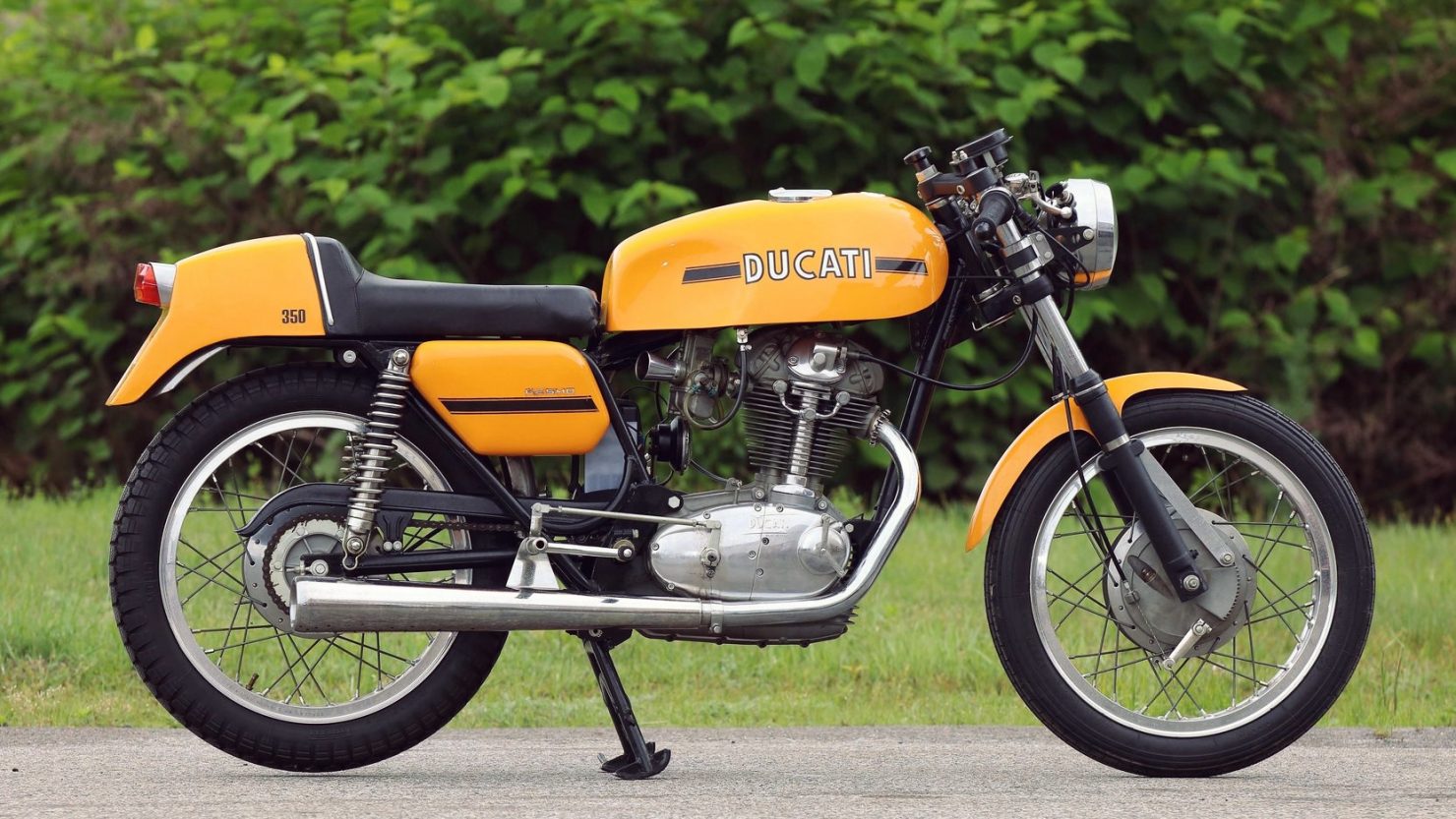
THE DESMODROMIC DUCATI
The Desmodromic engine is most closely associated with Ducati, the Italian marque turned to the technology in the late 1950s when they hit the RPM ceiling using a more traditional overhead cam engine with springs to close the valves.
In layman’s terms, a Desmodromic valve is both opened and closed by a cam (via a rocker arm typically), whereas a typical engine uses a cam or cam and pushrod to open the valve, with a spring to close it.
The downside the using springs for valve closing is that at higher RPMs the springs can no longer keep up and you get valve float – often resulting in valves and pistons meeting, which causes your engine to immediately and noisily become an expensive boat anchor. This has become much less of a problem as metallurgy and engineering knowhow has advanced, but Ducati have fine-tuned their Desmo engines and as the saying goes – if it ain’t broke, don’t fix it.
Chief Engineer Fabio Taglioni pioneered the use of Desmodromic valves in racing motorcycles for Ducati in the late 1950s, but it wasn’t until 10 years later that road-going Ducatis were fitted with Desmo power units.
In 1968 Ducati rolled out the new Desmo models, in 250cc, 350cc, and 450cc versions. All of them were single-cylinder designs, and the lessons learned by developing production Desmodromic engines were rolled into the first Ducati L-twins designed by Taglioni in 1970.
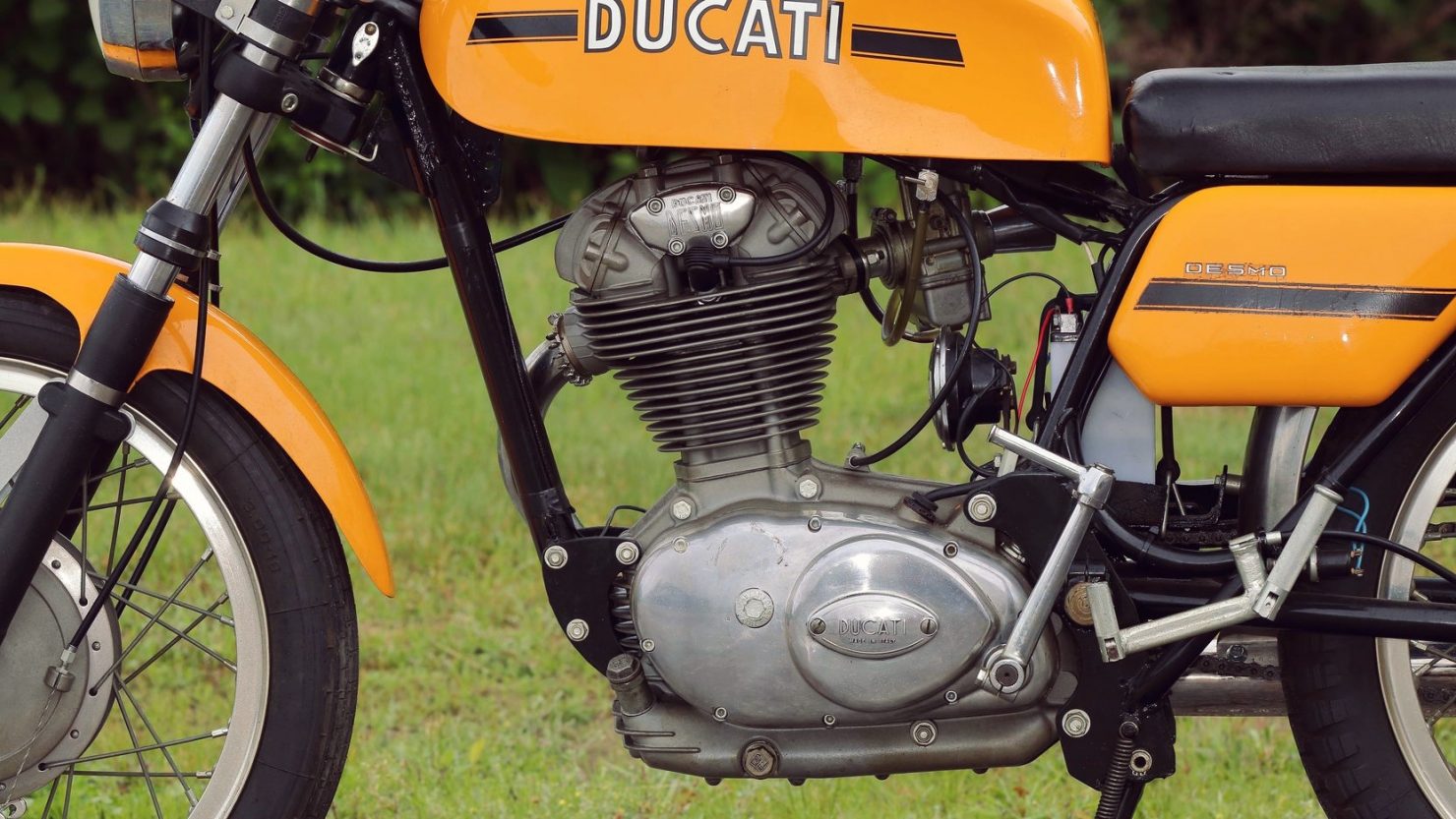
THE DUCATI DESMO 350 SHOWN HERE
The all-original Desmo 350 you see here was formerly part of the Saltarelli Moto Collection, many consider it to be one of the finest Italian mid-sized bikes of the era – thanks to its punchy single-cylinder motor, clip-on handlebars, racing seat, rearsets, and purposeful riding position.
There are few motorcycles as fun as a well-powered lightweight single, and there are few well-powered lightweight singles that can match a properly sorted Ducati Desmo 350. If you’d like to read more about this bike or register to bid you can click here to visit its listing on Mecum.
A TWO-WHEELED TESLA: THE CAKE KALK DUAL SPORT ELECTRIC BIKE
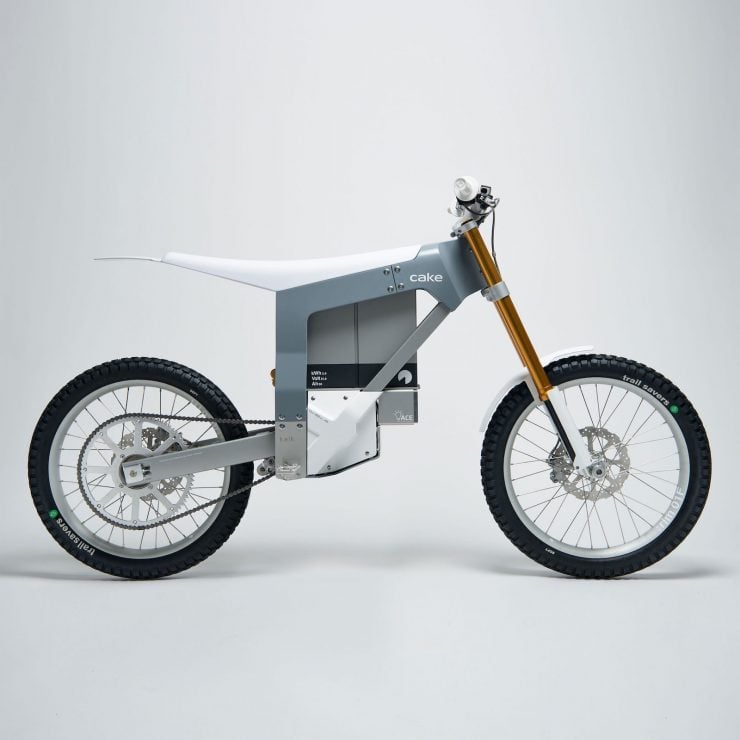
The CAKE KALK electric bike was designed from scratch to offer dual sport capabilities – for those who need to commute during the week, but want to hit the trails on the weekend. As battery technology continues to improve, we’re seeing electric bikes (and electric motorcycles) getting lighter, faster, and offering better range.
The KALK model is the first electric bike from CAKE, Swedish company dedicated to designing and building clean, high-performance electric bicycles with a focus on dual sport and off road riding.
THE ENGINEERING OF THE CAKE KALK ELECTRIC BIKE
In order to centralize mass, the IPM electric motor and the lithium-ion 51.8 Volt, 50Ah battery pack are located directly underneath the rider, with the heavy engine sitting low in the frame and driving the chain via a single pivot direct drive.
The CAKE KALK electric bike has a total weight of 70 kilograms and top speed of 80 km/h, with a range of approximately 80 km (depending on use and rider weight). The electric motor produces 15 kW and 42 Nm peak torque – that’s approximately 31 ft-lbs.
The overwhelming majority of components used on the KALK were designed in-house, including the axles, hubs, rims, the cockpit, and frame, with the suspension being developed in collaboration with fellow Swedes over at Öhlins.
The onboard software systems are updatable, meaning you’ll be able to download and install improvements over time. There are 3 riding modes at present, as well as adjustable motor braking and regenerative braking.
FRAME – SUSPENSION – BRAKES
The frame is extruded 6061 aluminum alloy that’s been CNC jointed and welded. The engine covers, fenders, and fork guards are carbon fibre, and the swing arm is extruded 6061 aluminum alloy.
The front suspension is a set of 38 mm Öhlins forks, with 204 mm travel, and adjustable compression and rebound. In the rear there’s an Öhlins TTX monoshock with a nitrogen reservoir, as well as 16 click low speed compression and 7 low speed rebound settings.
The front and rear brakes are 4 piston calipers with 220 mm stainless steel rotors, and alloy levers. The front and rear wheels are 24 inch, 50 mm 6061 aluminum alloy, with triple chamber rims and aerospace grade 7075 Power Hubs™. “Trail Savers” soft-compound tires are used front and back to minimize environmental impact and degradation of trails.
HOW TO BUY ONE
Pre-orders only just opened up a few days ago for the CAKE KALK – it’ll cost you €1,000 to reserve yours, and the final payment will be €13,000 – giving you a full MSRP of €14,000.
Obviously this will be out of reach for many, however there current global surge in interest surrounding electric cars, motorcycles, and bikes will likely mean there is no shortage of orders. Electric bicycles in particular are rapidly becoming the de facto form of transport for many in developing countries, and the larger European cities aren’t far behind.
With full aluminum and carbon fibre construction, a replaceable battery back and motor, and a reprogrammable ECU, the CAKE KALK is one of the more future-proof electric bicycles – and as with almost all electric vehicles, they require very little maintenance or servicing.







